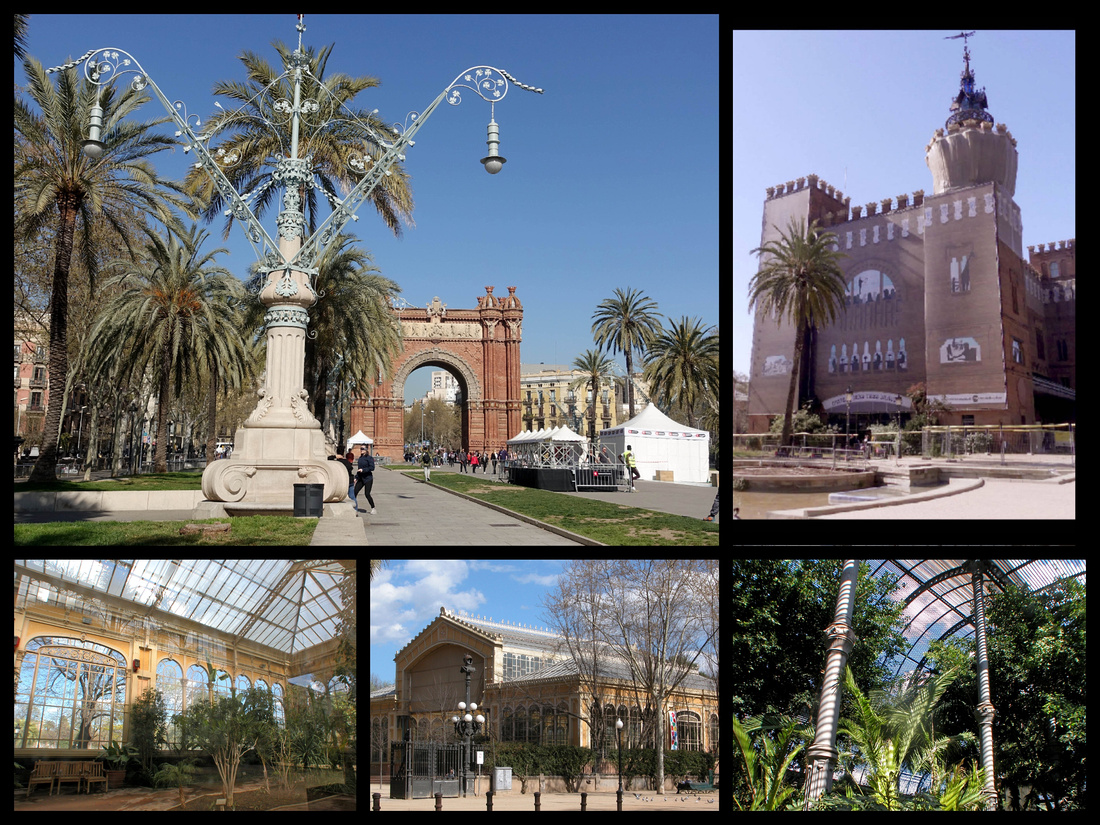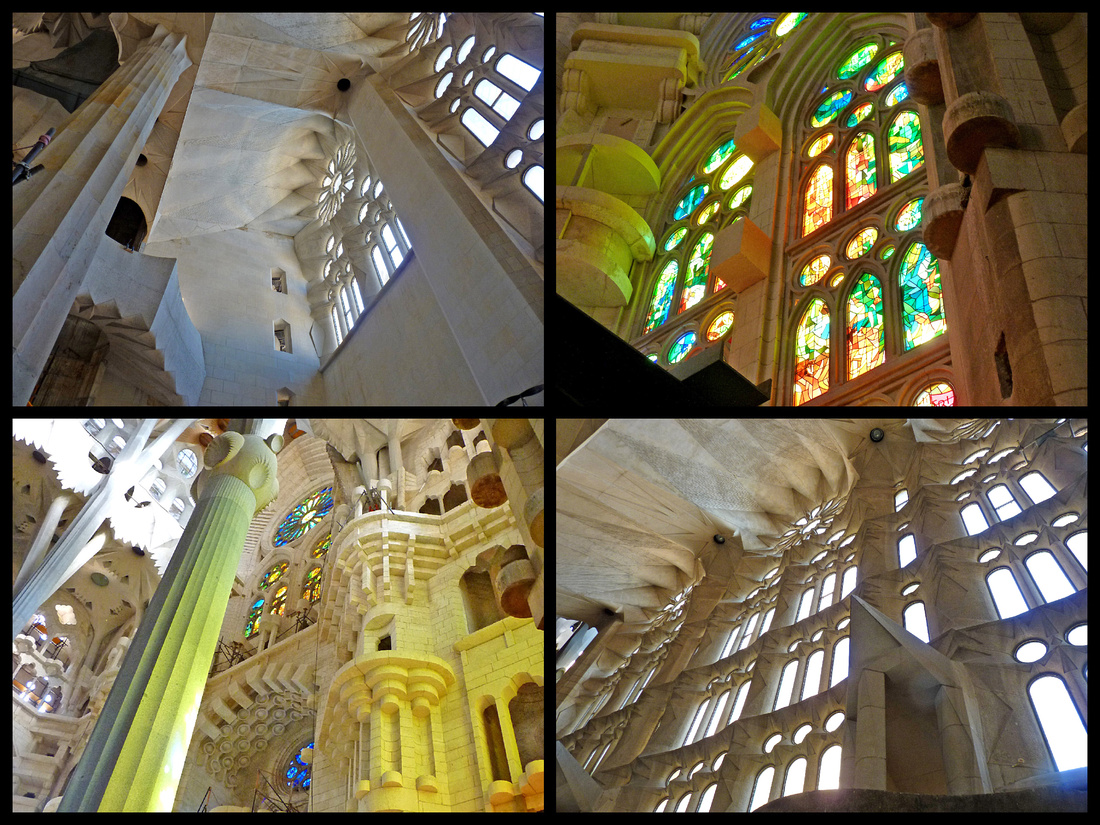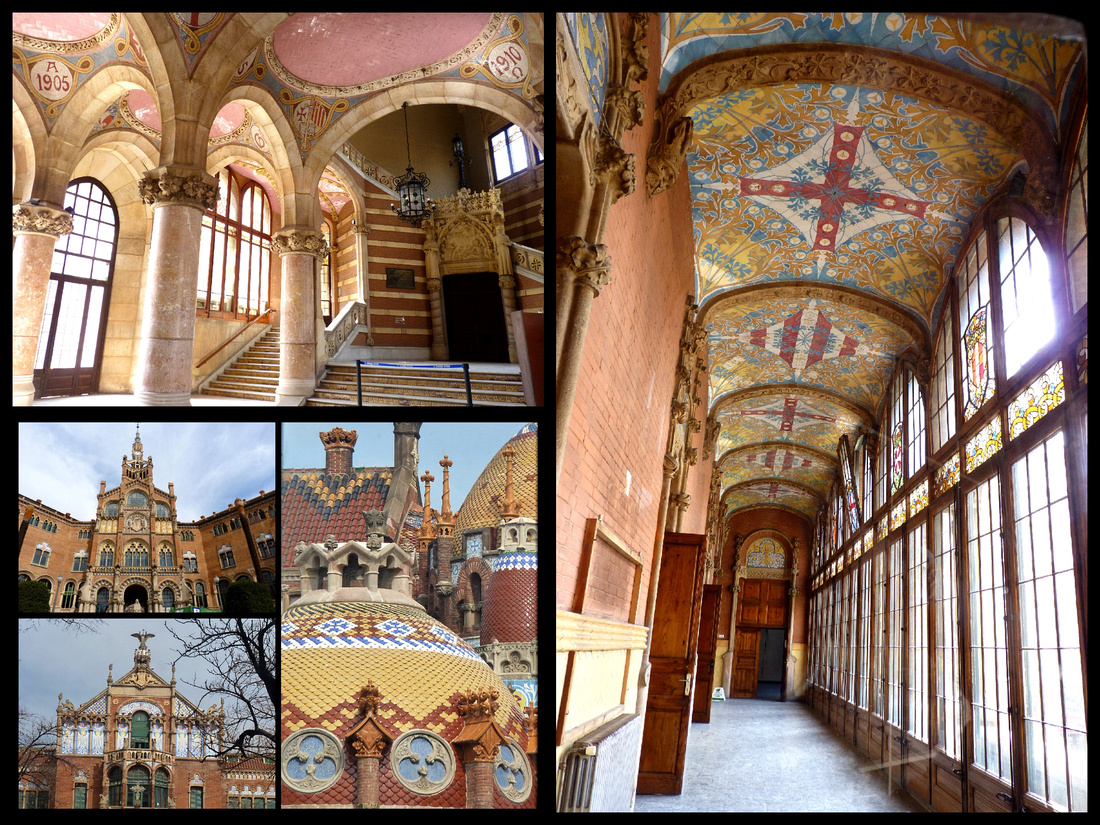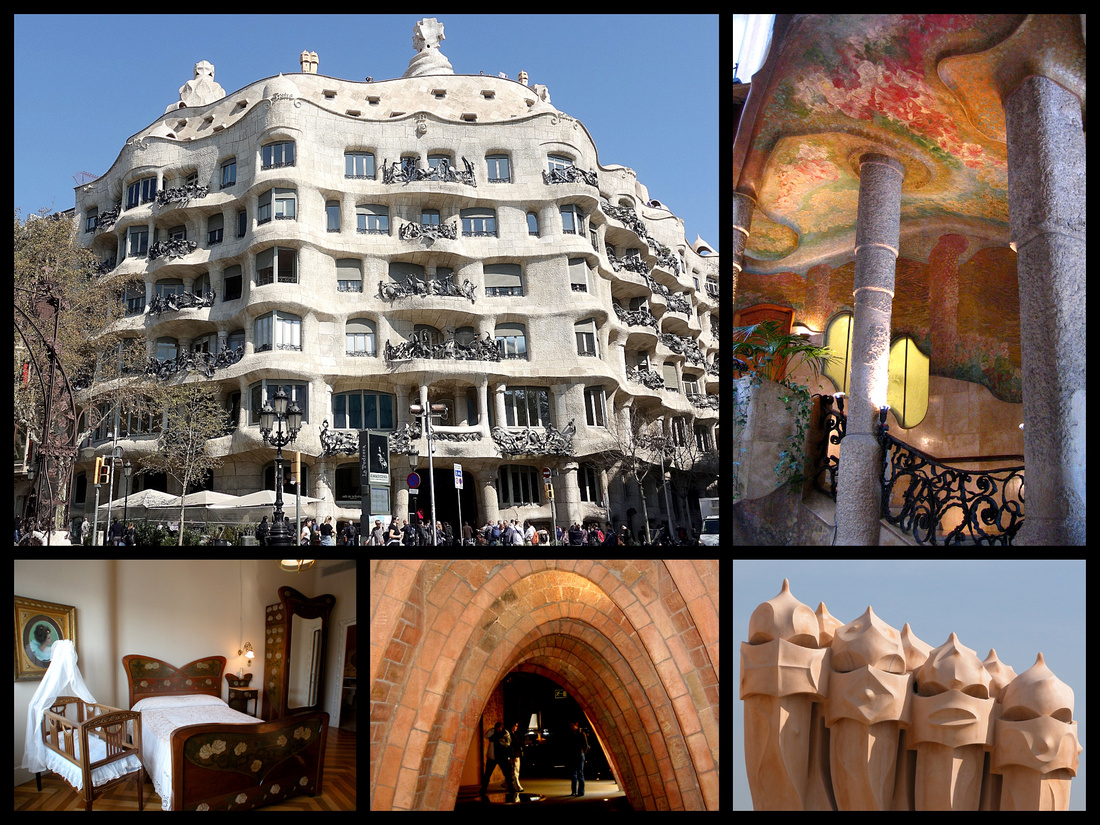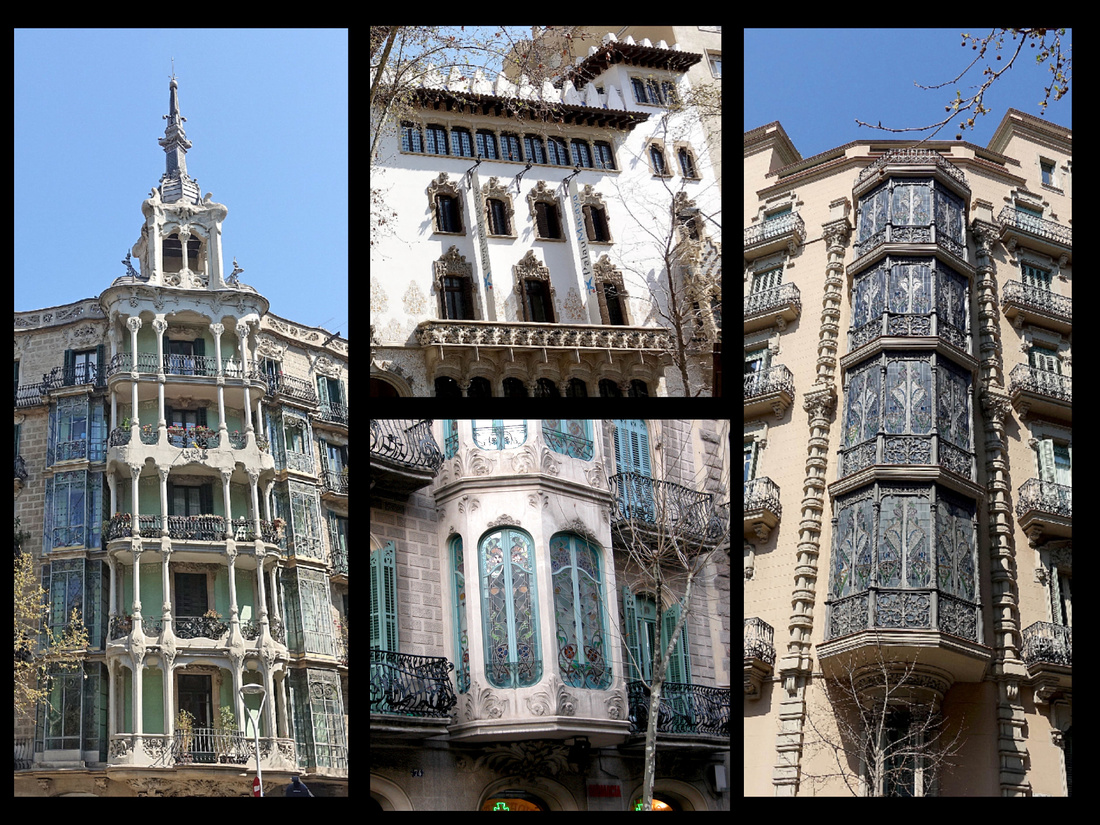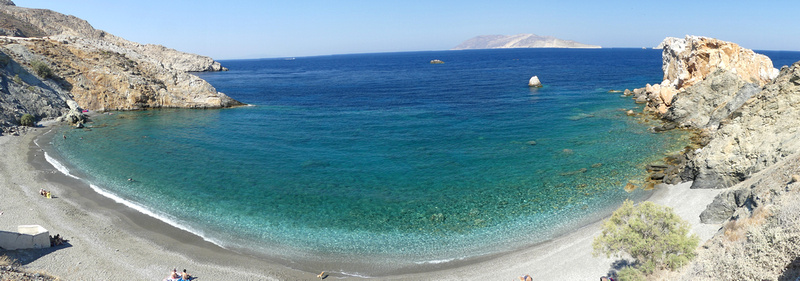


Spring in Spain - Part 3: Barcelona
BARCELONA
I had a little over two weeks in Spain in March and had beautiful sunny weather, highs in the 70s all but three days. The focus of the trip was to spend time on the islands of Mallorca and Ibiza and to visit Tarragona and Valencia but in between we had three nights in Barcelona. I had been to Barcelona on previous trips but my traveling companion had not and really wanted to see as much of Barcelona as possible in the short time we had. Without really intending to, this became the third spring break trip in a row that we visited a major European city in a very short amount of time and were able to see a lot of the major 'sites' in a really enjoyable way. We essentially spent a day in the Gothic old town center (and waterfront and Parc de la Ciutadella) and another in the Modernista Eixample. We also spent a few hours on Monjuic. Due to the limited amount of time and very long queues we didn't go inside Sagrada Familia, Casa Mila, or Park Guell, etc. Photos of those are from my previous trips (2006 and 2010).
Barcelona is Spain's second largest city (population 3 million) but the center with most of the sites is small enough that it can be walked in a couple of days and the metro is easy to navigate and goes everywhere else. Barcelona is far older than Madrid. Back when Madrid was still a small, Moorish outpost Barcelona controlled a large Mediterranean empire. The Moors did control it for a time but far shorter than elsewhere in Spain so Barcelona has had a different set of historical forces shaping it than the other places in Spain and in many ways looks different. There are two distinct sections to the city center, the original part, called 'Barri Gotic' with remnants going back to Roman times, with lots of medieval buildings remaining, and the 'newer' part famed for some of the best Modernisme buildings in Europe (known elsewhere as Art Nouveau) - especially those by it's most famous architect, Antonio Gaudi.
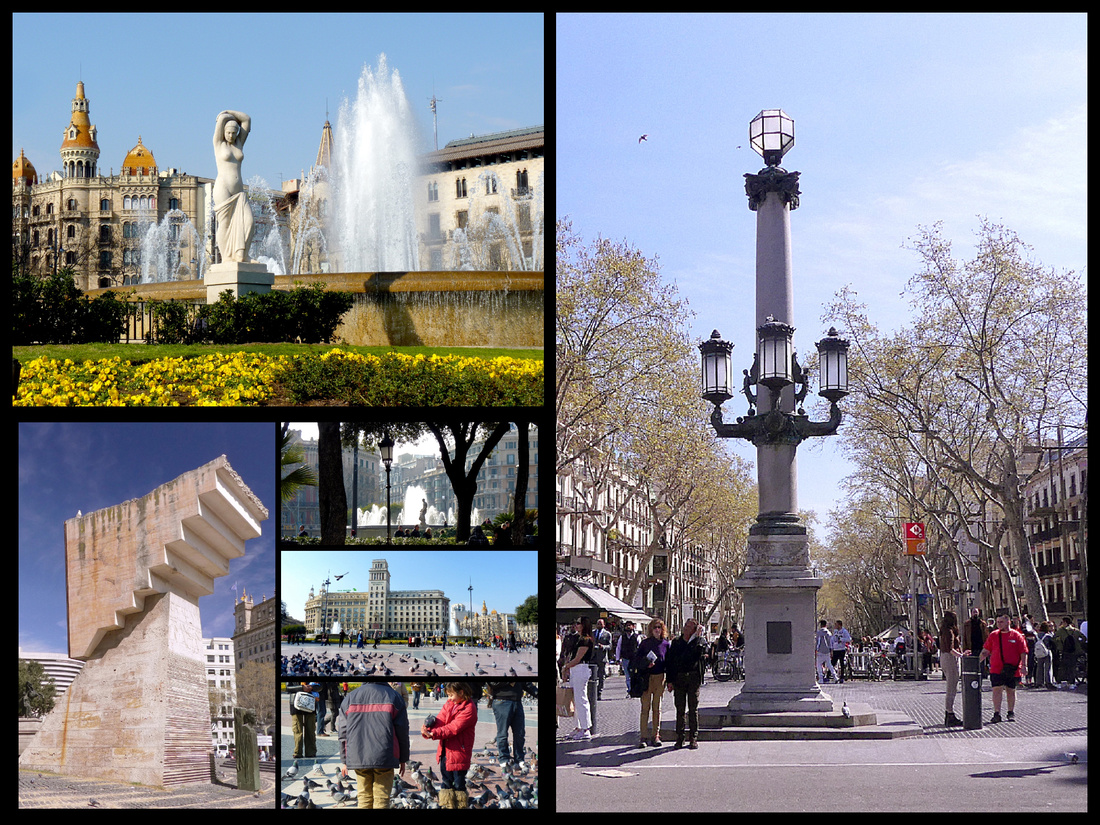
 Above Left: Place Catalunya Right: the start of Las Ramblas
Above Left: Place Catalunya Right: the start of Las Ramblas
Placa Catalunya is the central point of Barcelona, a large central square (actually it's round) one of the largest in Europe. In the center are two illuminated fountains, many statues and plenty of people performing (formally and informally). Around the square are large department stores including El Corte Ingles, (supermarket in basement, 9th floor terrace cafeteria with view). In front of El Corte Ingles is the Aerobus to the airport, the metro and the main tourist information office. La Rambla goes south to the old town and Passeig de Gracia and Rambla de Catalunya lead north to the Eixample.
Les Ramblas is a tree-lined, almost one mile long boulevard, one of the most famous streets in Spain - full of buskers and tourists, lined with hotels, cafes, and flower stalls. The name, derived from the Arabic ramla (or "sand"), refers to the bed of the seasonal stream which once flowed here. In the dry season, the channel was used as a road, and by the 14th C this had been paved over, a link between the harbor and the old town. In the 19th C, benches and plane trees were added, overlooked by stately balconied buildings, and today – in a city choked with traffic – this wide swath is still given over to pedestrians (with narrow vehicle lanes on each side).


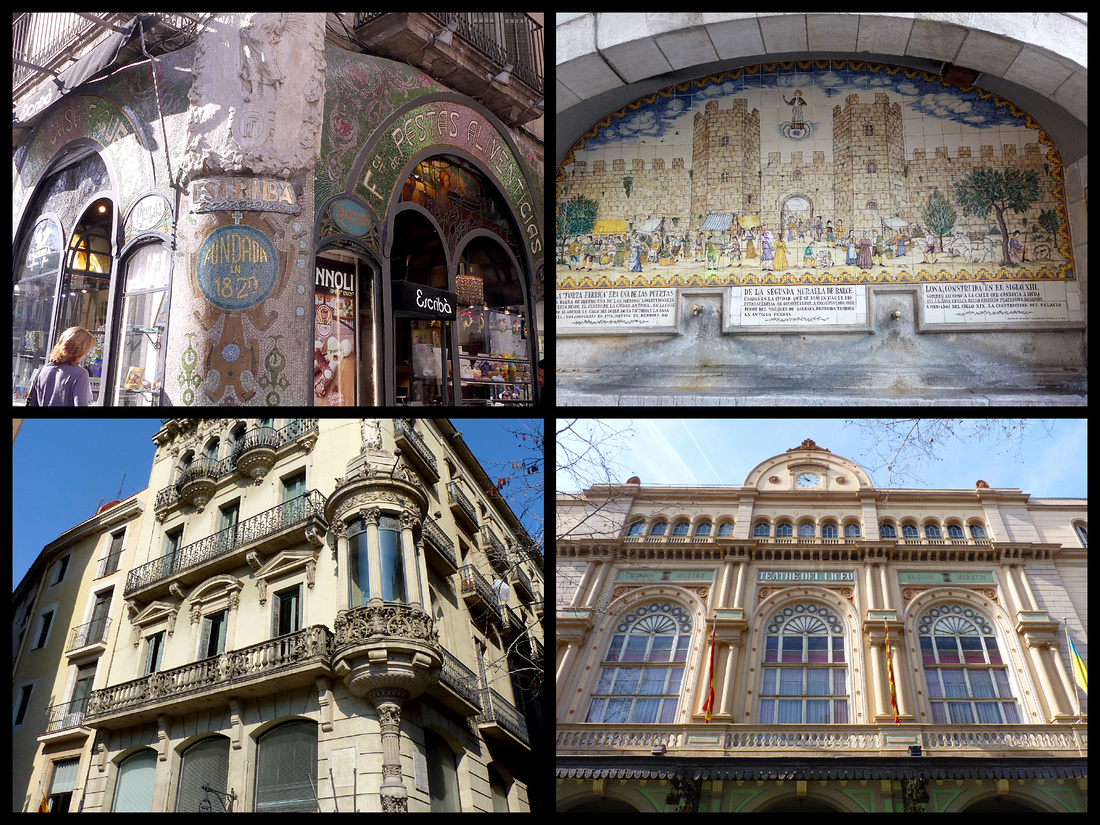

At the corner of one of the side streets off Las Ramblas, Carrer Portaferrissa, a shopping street lined with, among other things, several confectionary shops, is a fountain with a ceramic tile backdrop portraying the 13th century city walls and the gate which used to be there. Just across from there another side street leads to one of the highlights of Barcelona, La Boqueria (Mercat Sant Joseph), Barcelona's main market. There have been permanent food stalls here since 1840 and it was roofed over in 1914. There are hundreds of stalls selling fruits, veggies, meats, seafood, etc. plus a huge assortment of places selling prepared foods, several bars and restaurants. When the market was founded it was in one of the gates of the city walls where farmers from surrounding villages brought their products to sell.


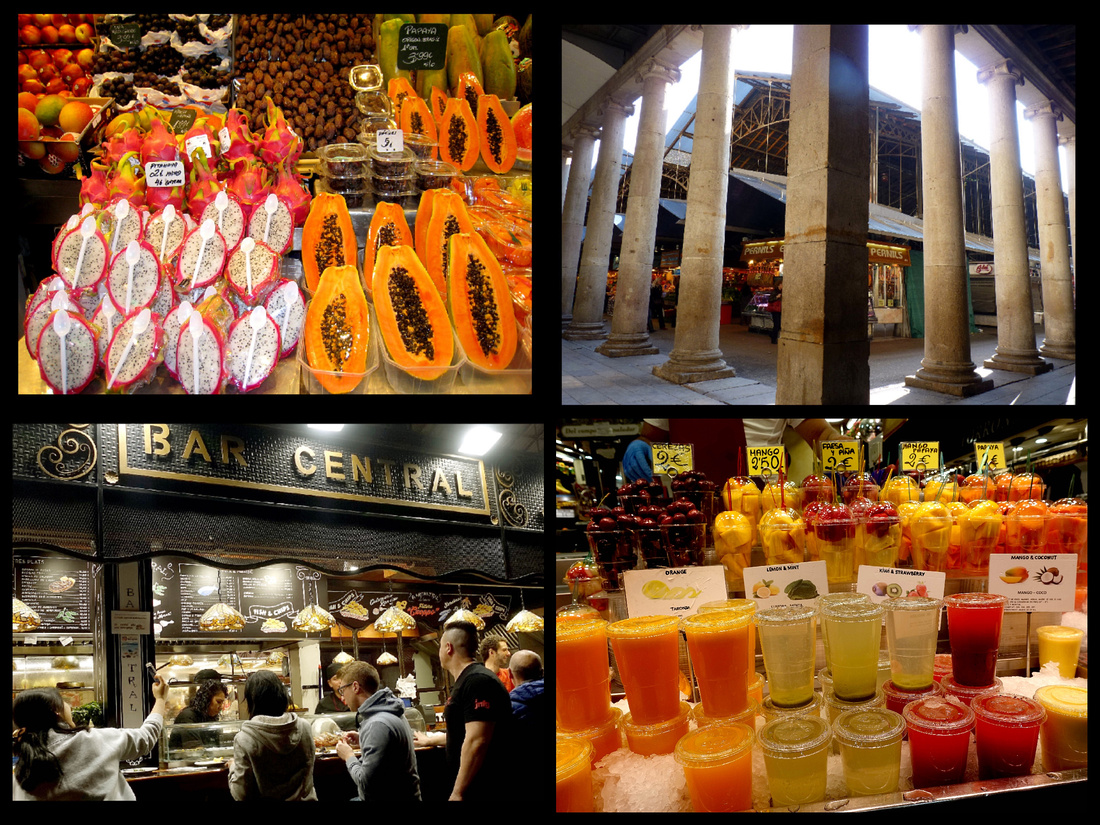

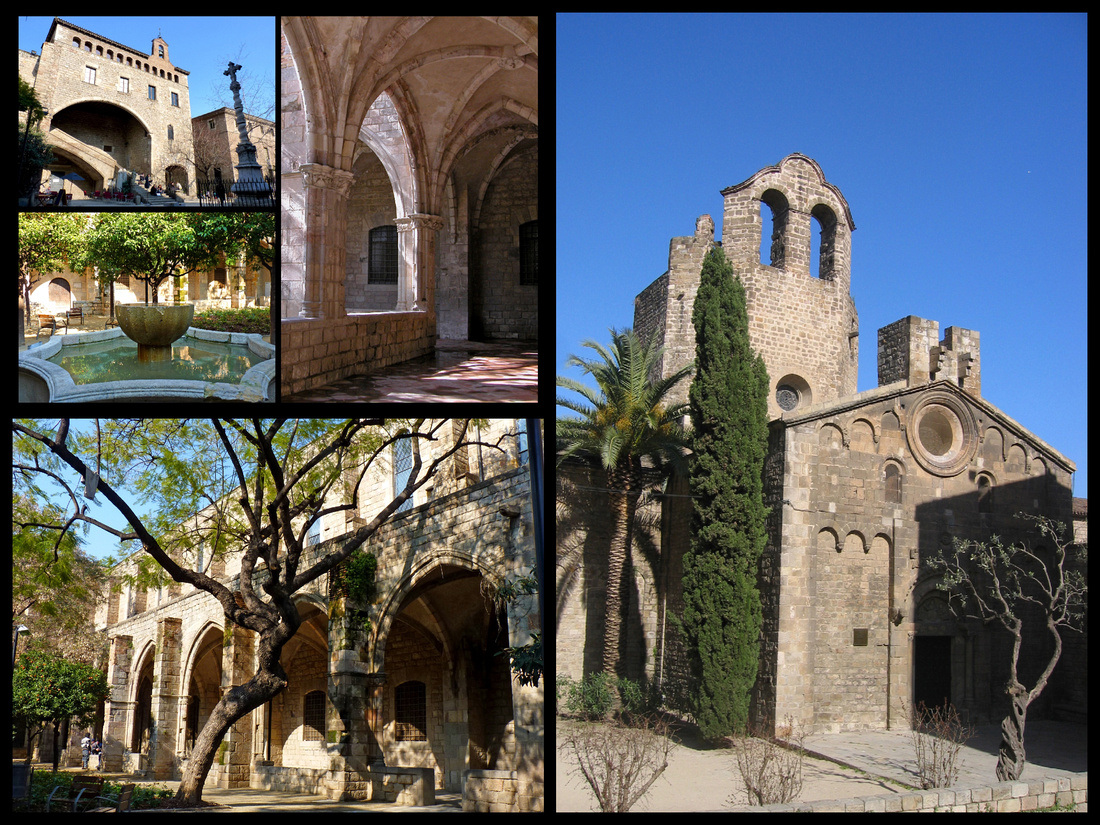

Above Left: Antic Hospital de la Santa Creu Right: Sant Pau del Camp
Antic Hospital de la Santa Creu is one of the oldest hospitals in the world, founded in 1024 and rebuilt here in 1401 with the intention of concentrating all the sick of Barcelona in one place. In the 16th C it had 500 beds, in the 17th it had 5000. Relocated in 1926 to the Modernista masterpiece near Sagrada Famila. One of the last patients to die at the hospital before it moved was Gaudi.
Sant Pau del Camp is Barcelona’s oldest church, built in 1127 (with some elements from the 6th C), surrounded by an olive tree, a cypress and a palm tree, it has faded Romanesque carvings on the façade plus a tranquil 13th C cloister. When it was built it was outside the city walls, as "del camp" (in the fields) suggests. The church is a kind of hulking shape, a reflection of the defensive mentality of Barcelona’s early Christians, for whom the church served as spiritual and physical refuge during an era of Moorish sackings and invasions.
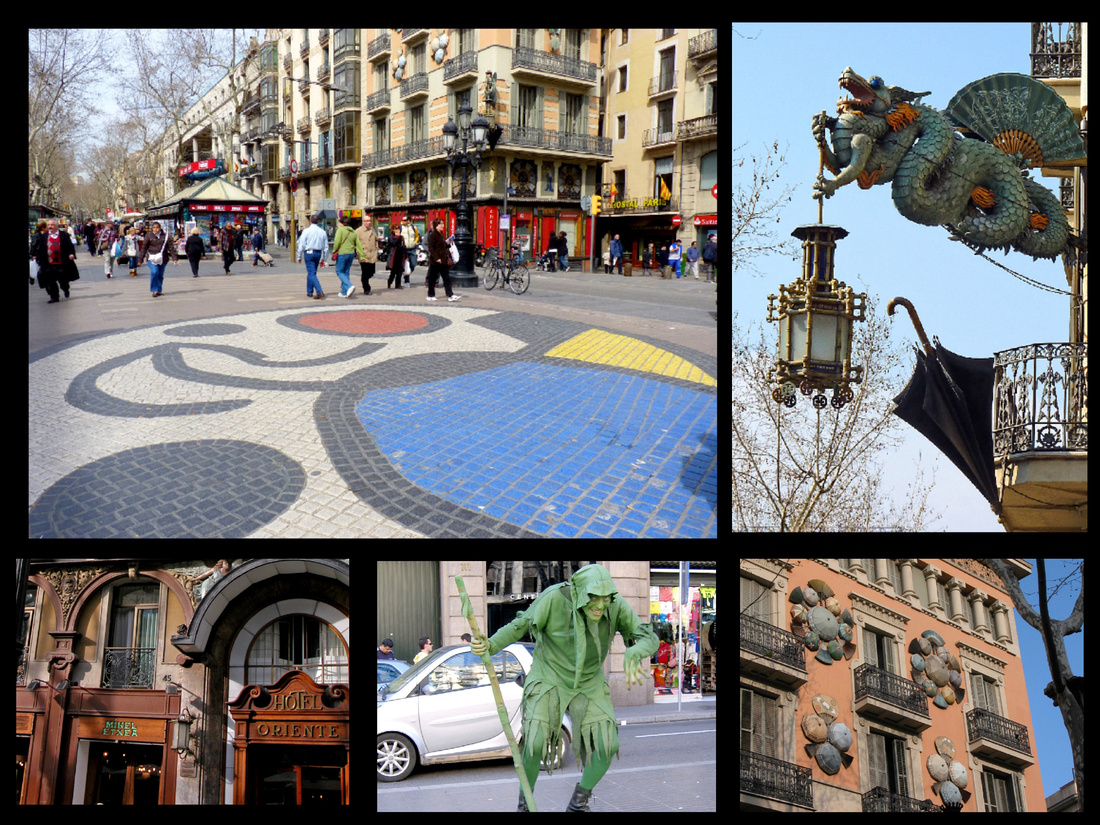

Above Top Left: Placa de la Boqueria in the center of Las Ramblas Right: Casa Bruno Quadros
Placa de la Boqueria marks the midway of La Rambla. There is a widening and absence of trees and in the center of the pavement is an anchor mosaic, a reminder of the city’s attachment to the sea, created by Joan Miro.
Casa Bruno Quadros A former umbrella makers, designed in 1885 includes a Chinese dragon with a parasol, Egyptian balconies and galleries, and a Peking lantern -- exotic touches all very much in vogue at the time of the Universal Exposition of 1888.
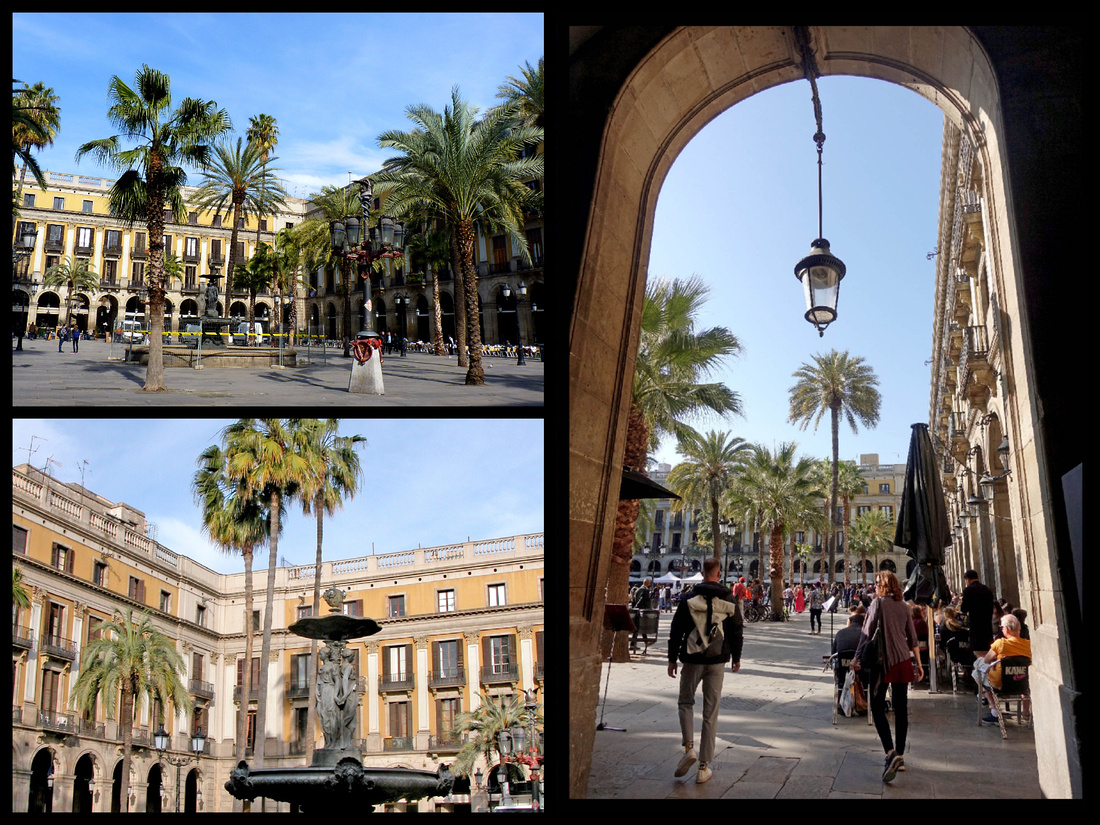

Above: Placa Reial
Placa Reial, a palm tree filled square can be reached through an arcaded lane off Las Ramblas. It’s Barcelona’s only square designed as a set piece, modeled after Madrid’s Plaza Major. An elegant Italianate neoclassical square has Gaudí's first public works: two helmeted lamp posts. The fountain in the middle depicts the Three Graces.
East of Las Ramblas is the "Barri Gòtic", the Ciutat Vella, or old city, one of the most evocative sites in Spain. Narrow winding streets (almost entirely pedestrianized) , with gurgling fountains, vintage stores, and ancient fortifications are contained in an area that was once entirely enclosed by 4th C Roman walls, but what you see today dates principally from the 14th C. Contained within this jumble of streets is a series of neighborhoods – originally separate medieval parishes and settlements – that retain certain distinct characteristics today. The greatest concentration of interest is in the area which curls out from around the cathedral.
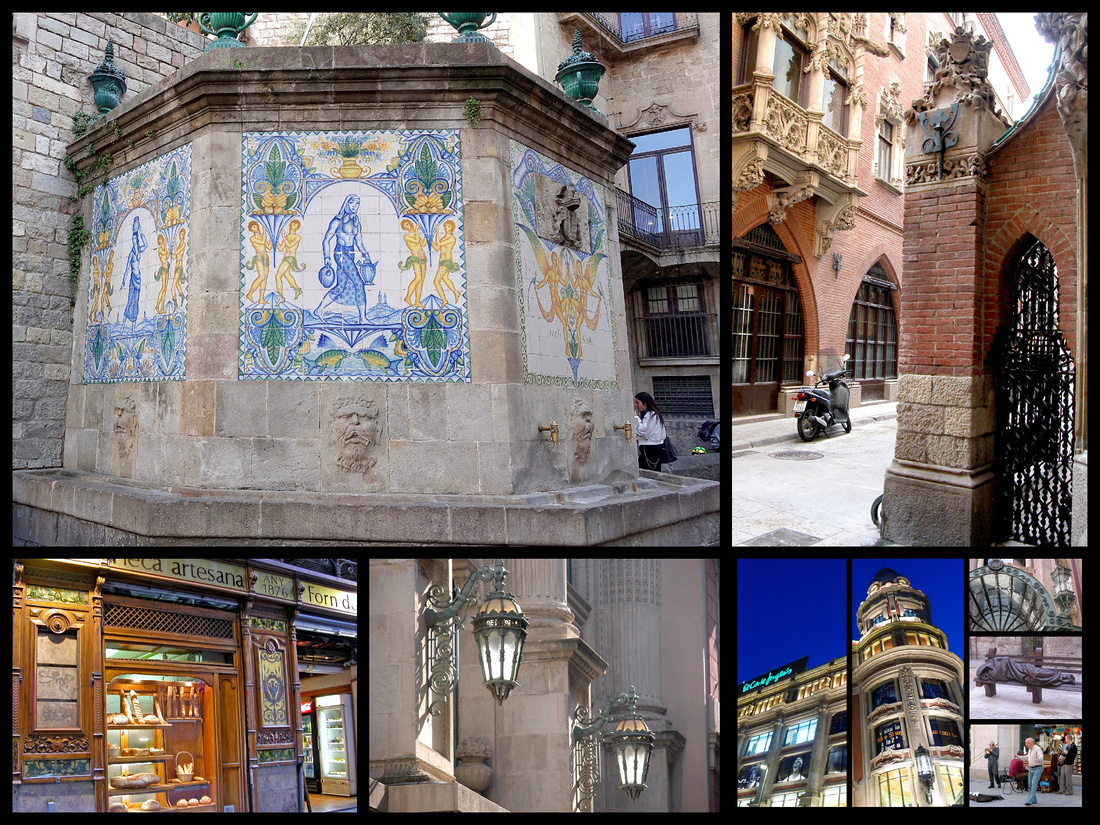

Above: Avinguda del Portal de l’Angel is the pedestrianized main shopping street leading from Placa Catalunya into the Barri Gotic. A large art nouveau building on the corner of C. Santa Anna houses a branch of El Cortes Ingles. Further down the street there is a three sided fountain above which are tile paintings of blue pitcher bearers.


Above - Left and top right: "The 4 Cats" Center and lower right: Santa Ana
The Church of Santa Ana, through a half hidden doorway off Carrer Santa Ana. The Romanesque church (1300) is in a small triangular courtyard. At the far end of the main aisle of the nave is an opening to the Gothic cloister where delicate columned arches frame the garden. Founded by the Knights of Templar in the early 12th C.
Casa Marti-Els Quatre Gats Built in 1896, this Art Nouveau building houses the ‘Quatre Gats’ café (Four Cats, slang for “just a few guys” but also recalling the Chat Noir in Paris). The exterior is decorated with Eusebi Arnau sculptures. The one on the corner is St Jordi and the dragon. The interior is hung with reproductions of famous Ramon Casas paintings. It was a bohemian taverna that provided much of the impetus for the city’s cultural life in the early 20th Century. Picasso’s first exhibition was held here. Today it has one of the best eating experiences in Barcelona, lunch consisting of three courses plus wine for €20.
Placa Nova/ Placa de la Seu are two squares which run together to form the largest square in the Barri Gotic, in front of the Cathedral and also features one of the main Roman gates to the old city, the Portal del Bisbe, or Bishop’s Gate. The two cylindrical towers date from the 1st Century BC but the name came later, from the nearby 18th Century Bishop’s Palace. Fragments of the Roman wall are visible in several parts of the walls and towers that extends from the Bishops Palace on the right to the House of the Pia Almonia on the left, beyond the steps leading up to the Cathedral. The sculpted letters spell out “Barcino” the Roman name for the city. An antiques market takes place in front of the cathedral on Thursdays.
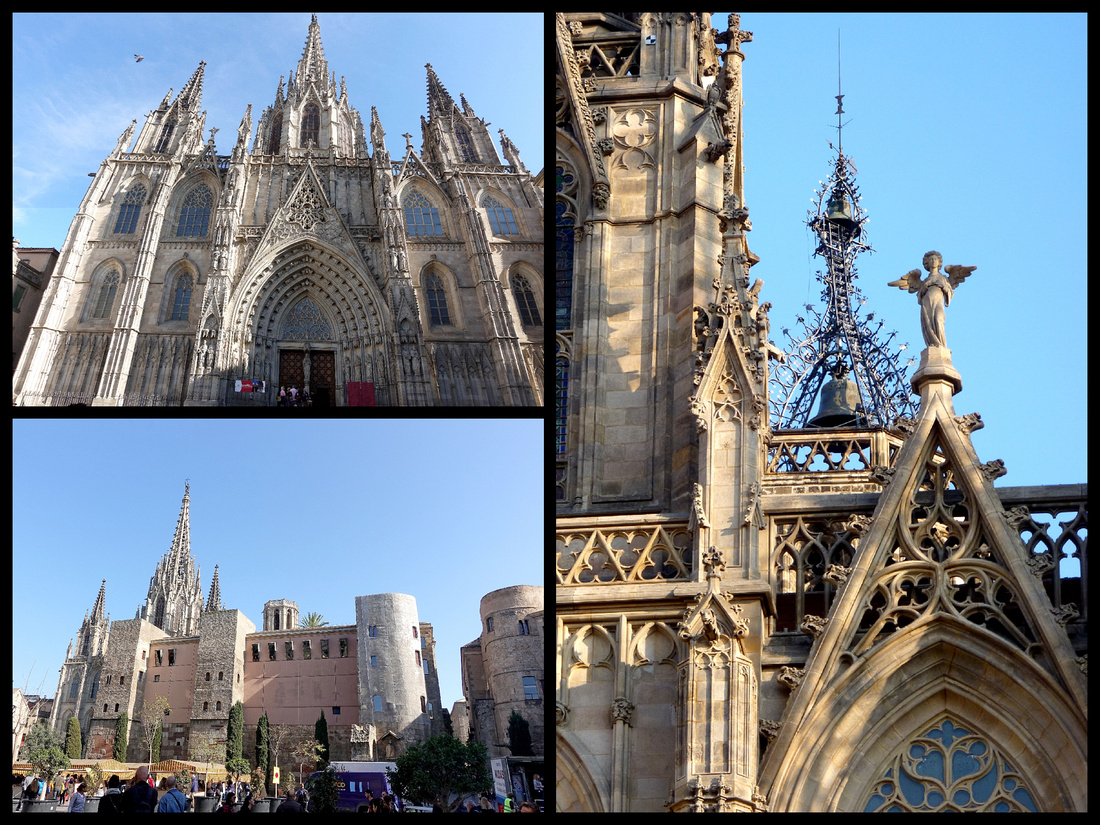

Above: The Cathedral (Le Sue) and Placa Nova/Placa La Seu
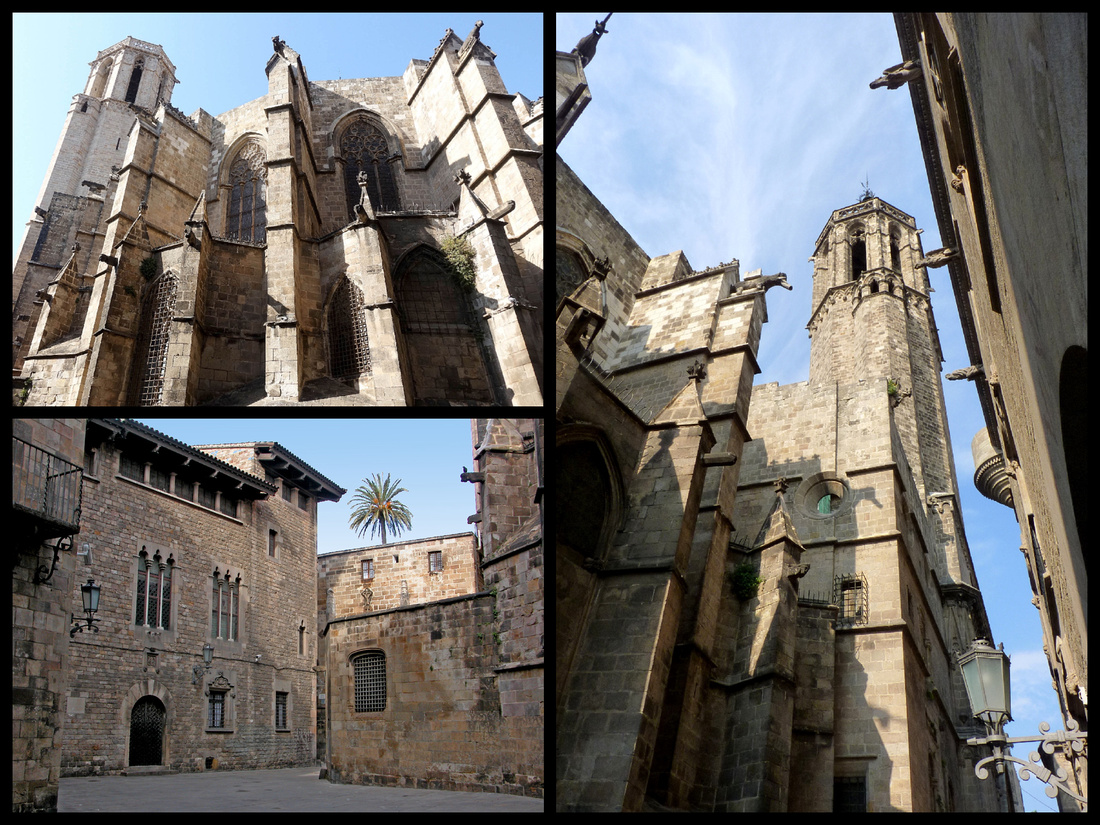

Above: Back and side of the cathedral
Barcelona’s Cathedral: La Seu With its large bell towers, blending of medieval and Renaissance styles, beautiful cloister, and Gothic arches, ranks as one of the most impressive cathedrals in Spain. Located on a site previously occupied by a Roman temple, the current building was begun in 1298. The Cathedral, named for La Seu, or See, the seat of the bishopric, was mostly finished by 1450, with the spire and neo-Gothic west facade added in 1892.
This is reputedly the darkest of all the world's great cathedrals, even at high noon, the nave is enveloped by shadows. The spacious interior, characteristic of Catalan Gothic buildings, is supported by buttresses. These provide walls for 28 richly ornamented chapels. While the main part of the church is fairly plain, the chapels show great wealth. They were sponsored by local guilds and provided a kind of advertising to illiterate worshipers. The most unique part of the cathedral is the 14th Century (1385) cloister which looks over a lush garden with palm trees, magnolias and is home to white geese, descendents of those who have lived there for five centuries. There is a fountain named after the geese – Font de les Oques. During festivals a dancing egg bounces in the fountain – the egg known as l’ou com balla symbolizes fertility. A tiny statue of St George slaying the dragon stands in the garden. There are 13 geese (13 in memory of Eulalia, a 13 year old girl, tortured 13 times by the Romans for her faith, crucified, and later sainted).
Outside, the apse is heavily buttressed and there are octagonal towers above the transept. The western bell tower has scrolled ironwork and a weather vane. Beneath it, animal gargoyles on top of the buttresses – unicorn, elephant, ram, dog, camel.


Palau Reial Major, The Royal Palace, on Kings Square (Placa del Rei), a block behind the apse of the cathedral. This plaza is widely considered the oldest and most beautiful space in the Gothic Quarter. Long held to be the scene of Columbus's triumphal return from his first voyage to the New World -- the precise spot where Ferdinand and Isabella received him is purportedly on the stairs fanning out from the corner of the square. The Palace features 13th Century triple recess arches with 14th Century rose windows. The silhouette of the box shaped Renaissance 15th Century Torre Mirador del Rei Martí (King Martin's Watchtower) with five tiers of round arches is an outstanding feature of the palace. The 14th Century Capilla Reial de Santa Àgueda (Royal Chapel of St. Agatha) is on the right side of the stairway and uses the Roman wall as it’s north side. The main room of the Palau is the Saló del Tinell, a magnificent banquet hall built in 1362. The Spanish Inquisition met here. Palau del Lloctinent (Lieutenant's Palace) is across Placa del Rei. 16th Century, façade (facing Placa del Rei).
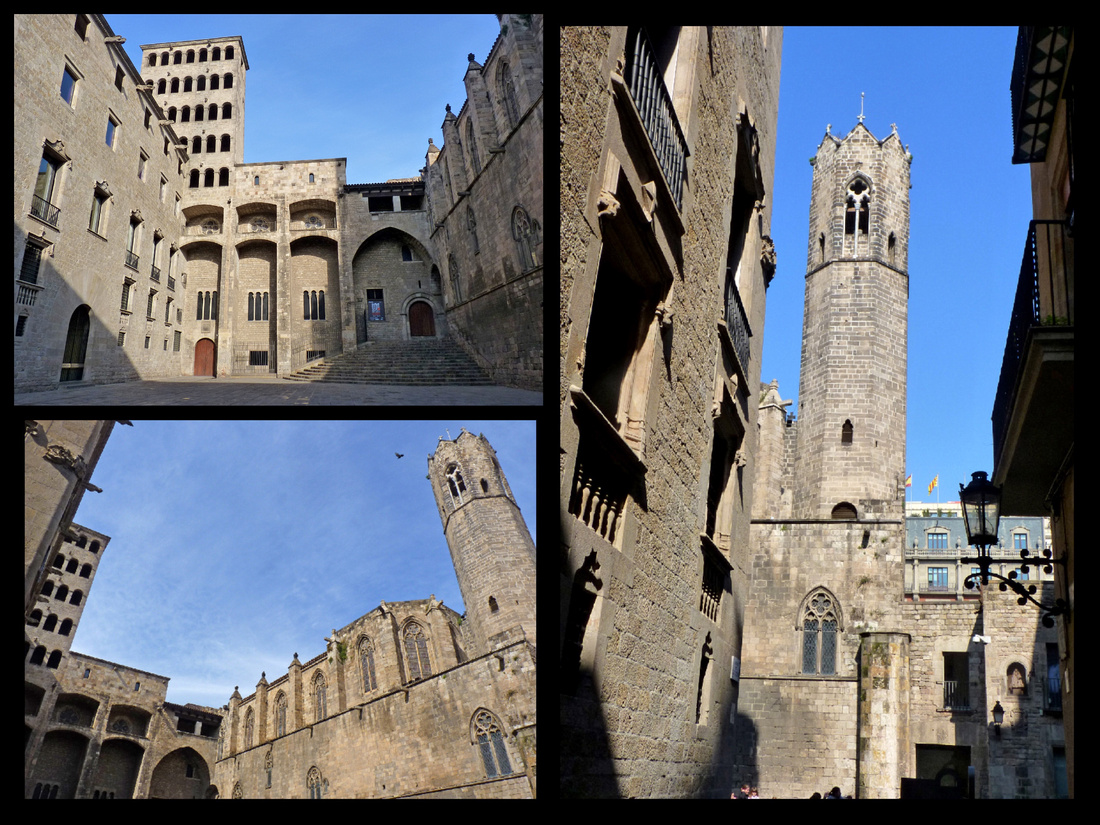

Casa de lArdiaca (Archdeacon's Residence) built in the 15th century on Roman ruins has one of the nicest patios in the city with a tall, elegant palm tree growing out of the center and a moss covered fountain in a tiled courtyard. The building houses the Municipal History Archives. It is just to the side of the main entrance to the cathedral.
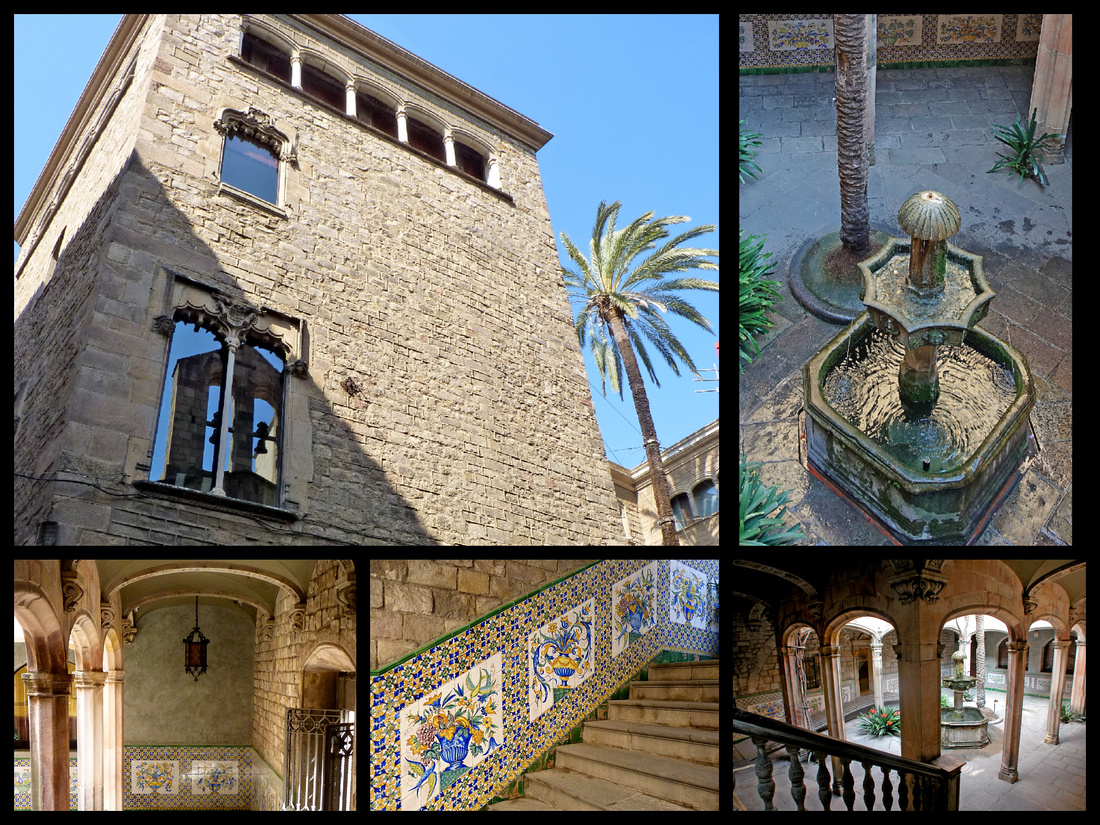



Above: Top Left: a Flamenco dancer in the tiny square, Placa de Garriga Bachs, next to the cathedral.
Right: Barcelona's "Bridge of Sighs", a pseudo Gothic passageway between two buildings on Carrer del Bisbe Iruita, built in 1928.
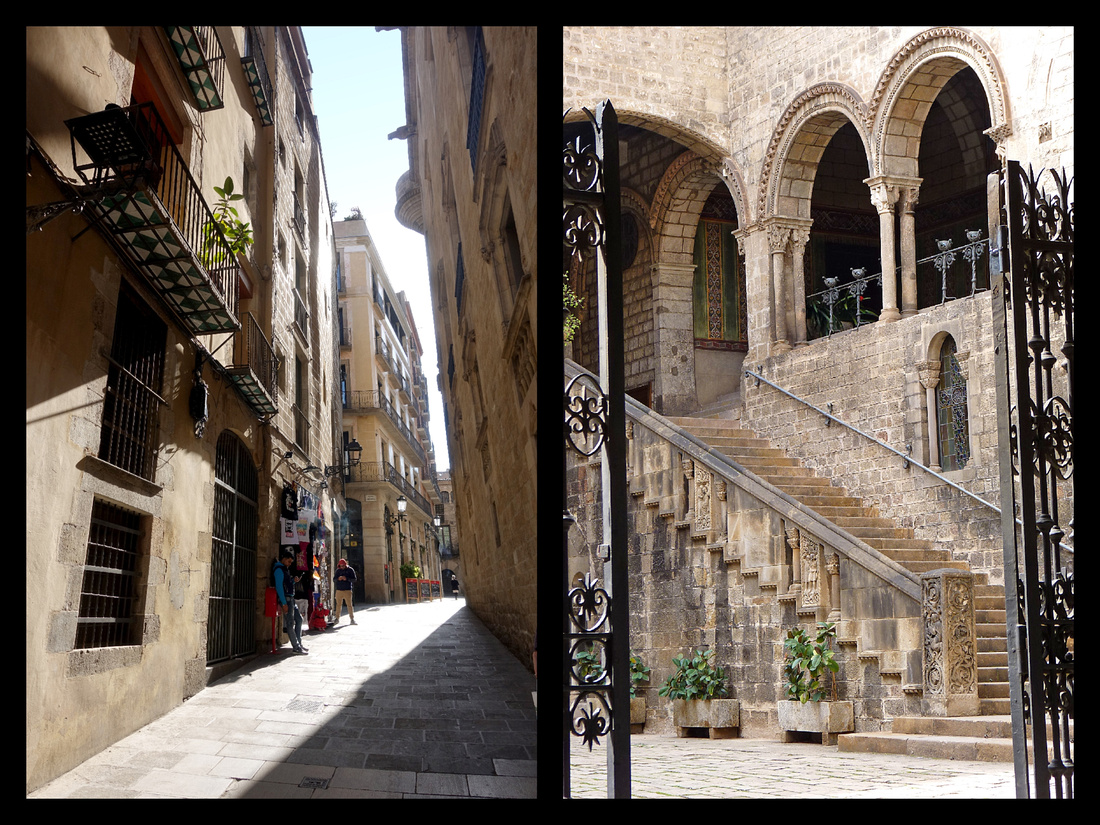

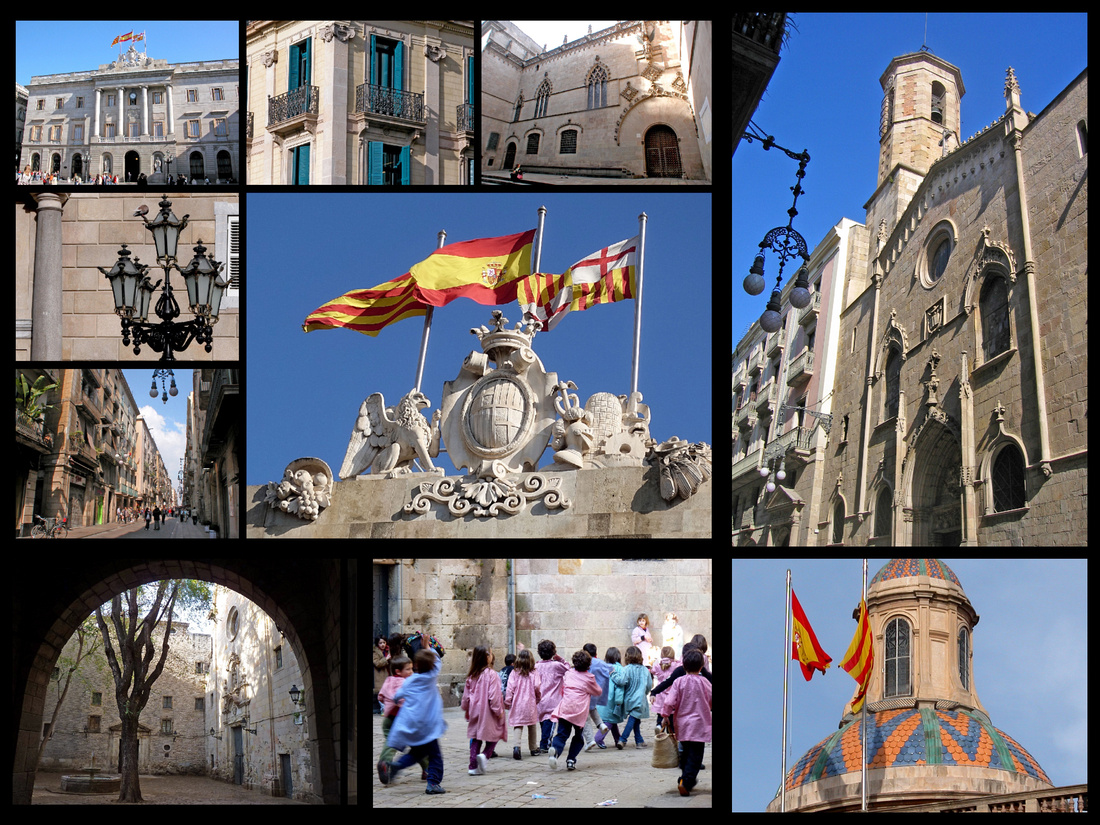

Above: Placa de Sant Jaume, Palau de la Generalitat, Carrer Ferran and Iglesia San Jaume.
Bottom Left & Center: Placa Sant Felip Neri
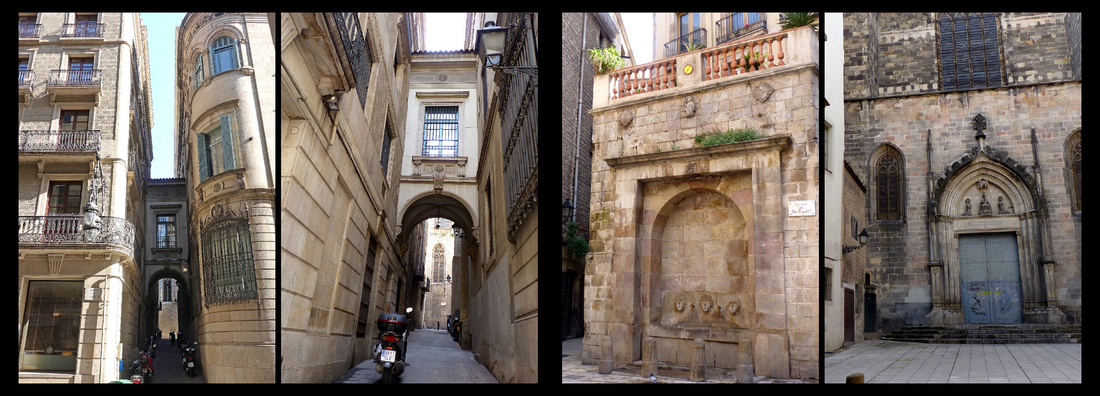

Above: From Placa Sant Jaume, Carrer Hercules leads to Placa St Just, one of Barcelona's hidden gems, home to one of the oldest parish churches in Barcelona, built about two centuries before Columbus discovered America. In addition to the (usually closed) entrance to the church there is a fountain with three faces.
Palau de la Musica Catalana Built in 1908, this theater has one of the best modernist interiors in a town known for it’s modernist architecture. The decoration includes busts of Wagner, Beethoven and Bach. A disciple of Rodin, Miquel Blay, sculpted the huge corner exterior group that projects like a figurehead on a ship with a knight and damsel emerging from a cloud of legendary figures that celebrate Catalan popular song. Inviting arches lead into the 2000 seat hall full of stained glass and ceramics including a huge stained glass skylight. It’s the only concert hall in Europe to be naturally lit. A UNESCO site. Attending a performance of a Catalan Guitar trio was a highlight of our trip. The music was very nice, but being in those surroundings was incredible.


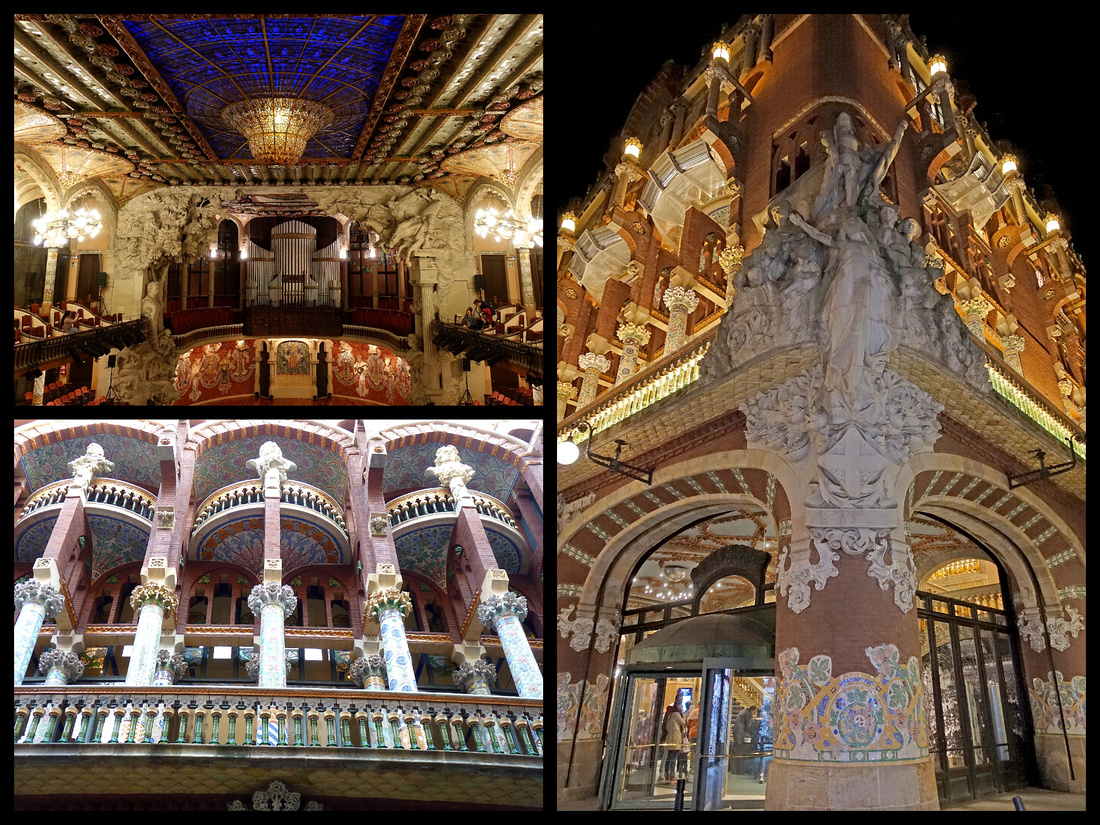

La Ribera / El Born In the old tradesmen’s quarter the street names echo the crafts they practiced: Argenteria (silversmith), Mirallers (mirror makers), Sombrerers (hatters). This was the old maritime district and C de L’Argenteria the main road to the port. In the days before Barceloneta the sea washed up this far. Bacilica de la Merce, 1267 but heavily remodeled in Baroque times. The Placa by the church is often deserted except for an early 19th C statue of Neptune with four sphinxes. The interior streets of the area are narrow alleys but running along side is the Passeig Picasso, a wide boulevard with stately mansions across which is Parc de la Ciutadella.
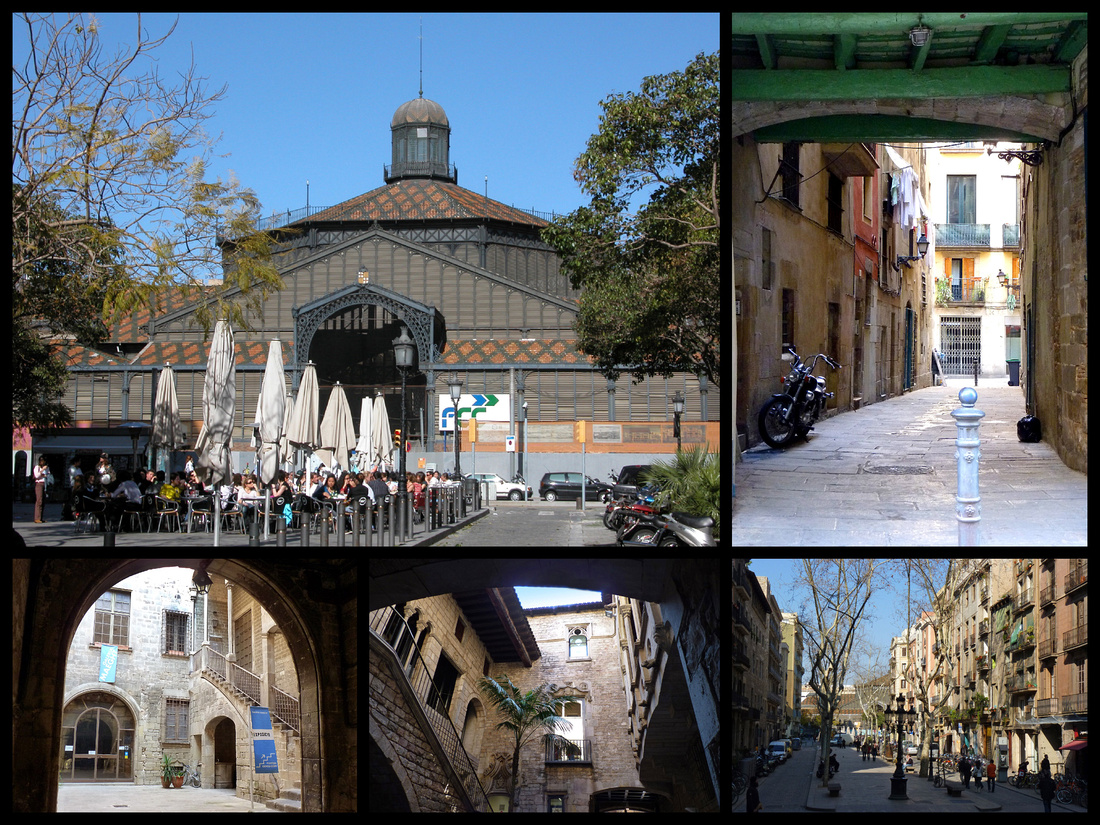

Above: Top Left - Mercat del Born Bottom Left and Center: Picasso Museum courtyard


Above - Right: La Merce Top Left: small square near La Merce Lower left: Mercat Santa Caterina (1848)


Above: Old town streets of Barcelona, they are among my favorite old towns of any city in Europe.
Parc de la Ciutadella was once the site of a Bourbon fortress, now a formal park, with a zoo and museums as well as paths and gardens. It was transformed in 1888 from a military citadel into a park for the Universal Exhibition (World’s Fair). There is a lake and a huge ornamental Baroque fountain: La Cascada, designed by Josep Fontsere who was assisted by a young Gaudi.
Placa d’Armes, in the center near the zoo, was the old parade ground, now a formal garden with a Rodinesque nude (1907) slumped over the weight of sin. The square has the only surviving buildings from the Ciutadella: a chapel, the Governor’s Palace and the Arsenal.
A tropical cast iron greenhouse with a wood lattice roof, the Umbracle (1884), and the Hivernacle, a pink walled iron and glass open-ended conservatory sit on the Passeig Tilers next to the Museu de Geologia.
Just inside the main entrance is a castle-like building intended for use as the exhibition’s café-restaurant, dubbed the Castell dels Tres Dragons, it became a centre for modernista arts and crafts and is now the Museu de Zoologia.
The stately Triumphal Arch (Arc de Triomf) at the top of the park was built as the main entrance to the Universal Exhibition of 1888. The Passeig de Lluis Companys joins the arch to the Citadel Park – these long rectangular gardens are similar to the Tuillieries in Paris except for the ugly apartment blocks to the side.
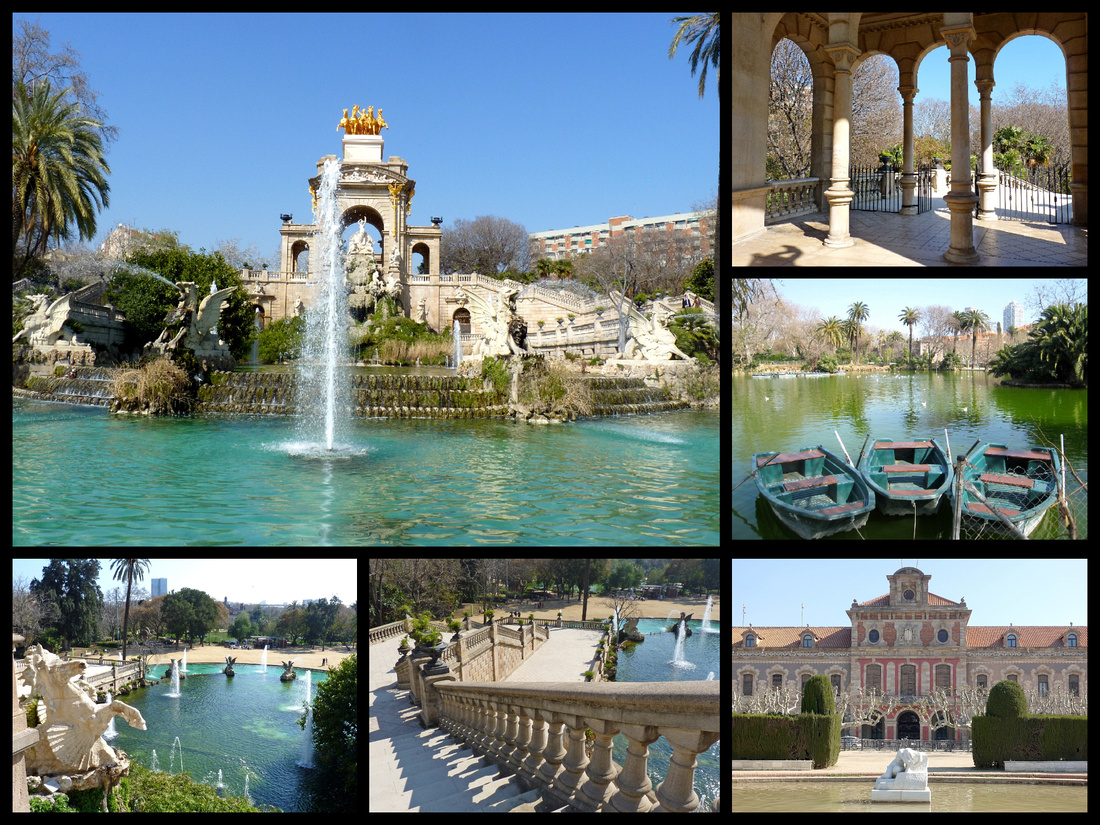



Barcelona's marina stretches the length of Passeig de Joan de Borbó, and encompasses large pedestrian wharves (molls), including Moll de la Fusta – the city's old timber wharf which has been landscaped with benches and trees. Just beyond the Lichtenstein sculpture Barcelona Head, aka "El Cap", is the huge Post Office building/ Correusi (1927) (on Via Laietana) with uneven towers.
From Moll de la Fusta, a swing bridge, La Rambla del Mar, leads across the harbor to Moll d’Espanya and the area known as Port Vell (old port) where some of the most exclusive yachts in the Mediterranean winter. The main thing on the Moll d’Espanya is the leisure complex known as Maremàgnum – with shops and restaurants. The soaring glass lines of the complex are tempered by the undulating wooden walkways. Attractions here include a multi screen cinema (IMAX), and L'Aquàrium, one of the largest in Europe.
El Transbordador Aeri del Port is the cable car which goes from the tower at the end of Passeig Joan de Borbo, connects with the Torre de San Sebastian on the Moll de Barceloneta, the tower of Jaume I in the boat terminal, and the Torre de Miramar on Montjuic.
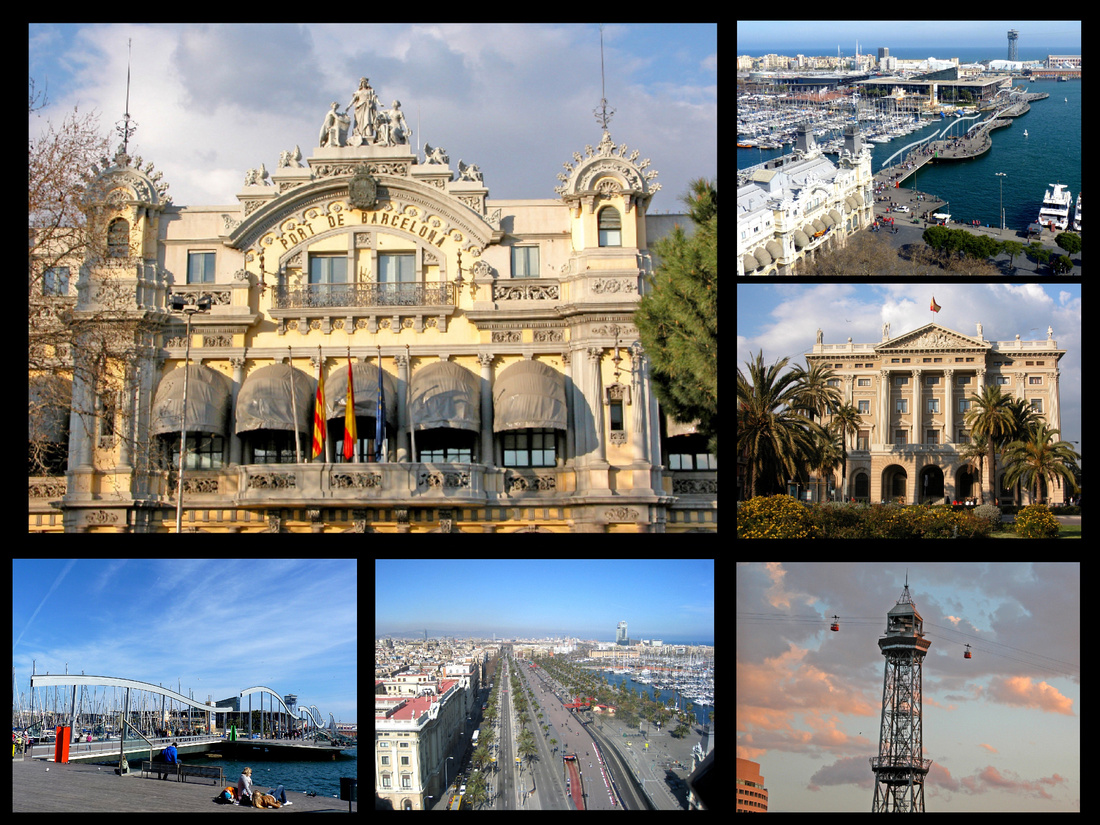



Above - Moll de la Fusta Center top "el Cap" Right: Monument a Colom
Monument a Colom - A 60 metre column at the foot of Las Ramblas built for the 1888 exhibition to commerate the fact that Columbus returned from his famous voyage to the New World to Barcelona. You can take a (very tiny) lift to the top for great views of Barcelona.
Once Barcelona's pungent fishing port, Barceloneta retains a bit of maritime flavor, with narrow streets and lines of laundry snapping in the breeze. The area was laid out in 1755, by a French military engineer as a fishing community in an area that had previously been mud flats. It was designed in uniform style to make crowd control easier. The main reason most people come here now are the seafood restaurants. It’s a short walk from Barceloneta to the beach. Barcelona’s Beach starts at the tip of the peninsula and stretches for 2.5 miles up the coast to the Olimpic Port. Palm trees, cement walkways, tons of sand – all were installed in the mid 1980’s in preparation for the 1992 Summer Olympics. The area was previously all warehouses and industrial slums. The whole area is called Parc de Mar- port Olimpic. Frank Gehry’s goldfish sculpture is in front of Barcelona’s first skyscraper, the Hotel Arts.
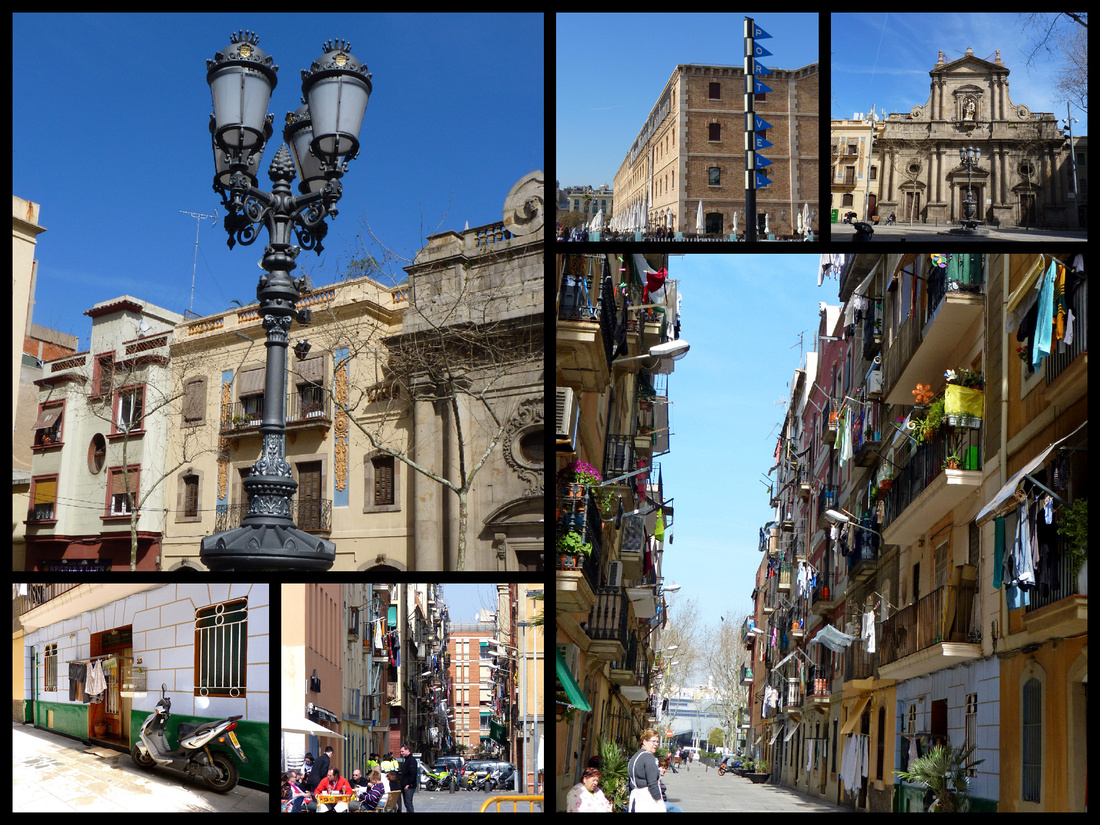

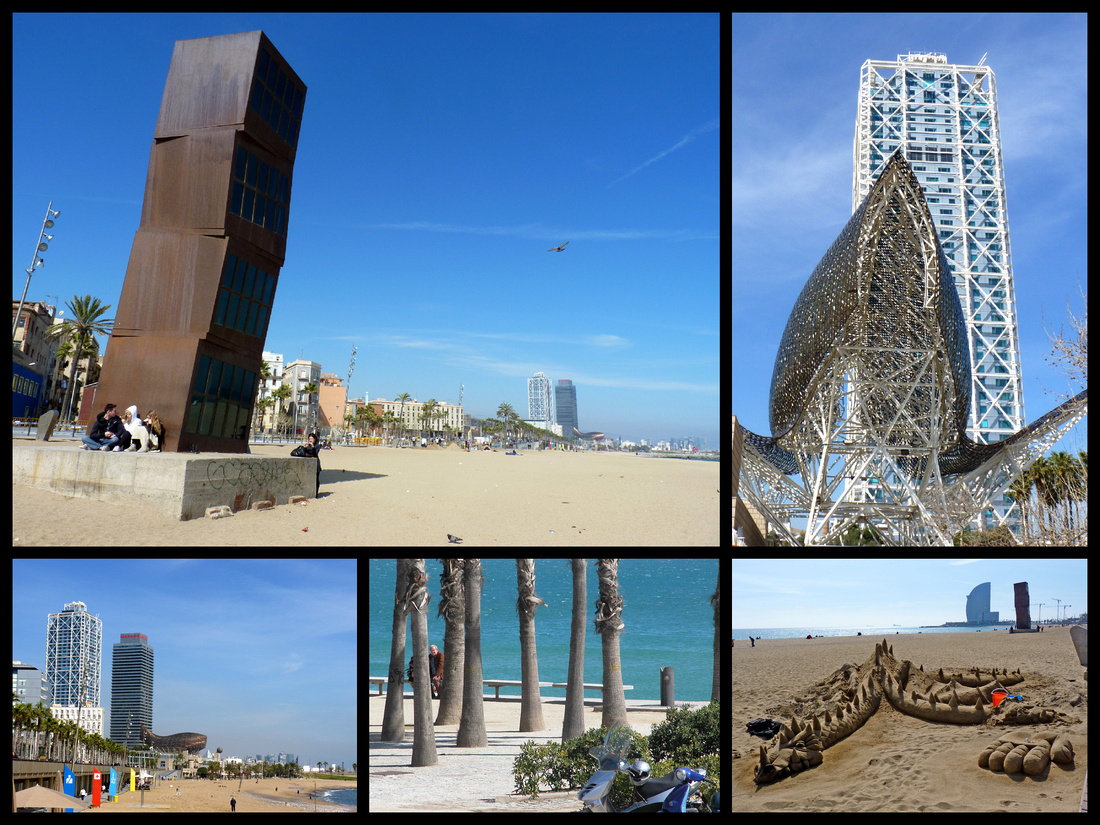

EIXAMPLE
Barcelona grew more prosperous and crowded throughout the 19th C, and by the 1850s it was clear that the city had to expand beyond Plaça de Catalunya. The plan that was accepted was that of an engineer, Ildefons Cerdà, who drew up a grid-shaped new town to the north, intersected by long, straight streets and cut by broad, angled avenues. Work started in 1859 on what became known in Catalan as the EIXAMPLE, or "Widening". Barcelona snipped off the building corners to create light and spacious eight-sided squares at every intersection. The plan, which was never completely carried out, was to have each 20 block area have it’s own hospital and large park. Each 10 block area would have it’s own schools, markets, etc. The hollow area formed by the buildings in each block would form a neighborhood park. The Eixample is still the city's main shopping and business district, spreading out on either side of the two principal and parallel streets, Passeig de Gràcia and Rambla de Catalunya, both of which cut northwest from the Plaça de Catalunya.
As the money in the city moved north, so did a new class of modernista architects who began to pepper the Eixample with ever-more striking examples of their work, commissioned by status-conscious merchants and businessmen. These buildings turn the Eixample into a huge urban museum around which it's a pleasure to wander. No architect was as fantastical as Antoni Gaudí (1852-1926), the foremost proponent of Catalan modernismo. This eccentric genius conceived buildings as "visions." A recluse and a celibate bachelor, he lived out his own fantasy. Nothing is more stunning than his Sagrada Familia, Barcelona's best-known landmark, a cathedral on which Gaudí labored for the last 43 years of his life before he was tragically killed by a tram in 1926. If it's ever finished, "The Sacred Family" will be Europe's largest cathedral.
UNESCO World Heritage Lists seven properties built by Gaudí in or near Barcelona including Parque Güell, Palacio Güell, Casa Mila, Casa Vicens, Sagrada Familia, Casa Batlló, and the Crypt in Colonia Güell.
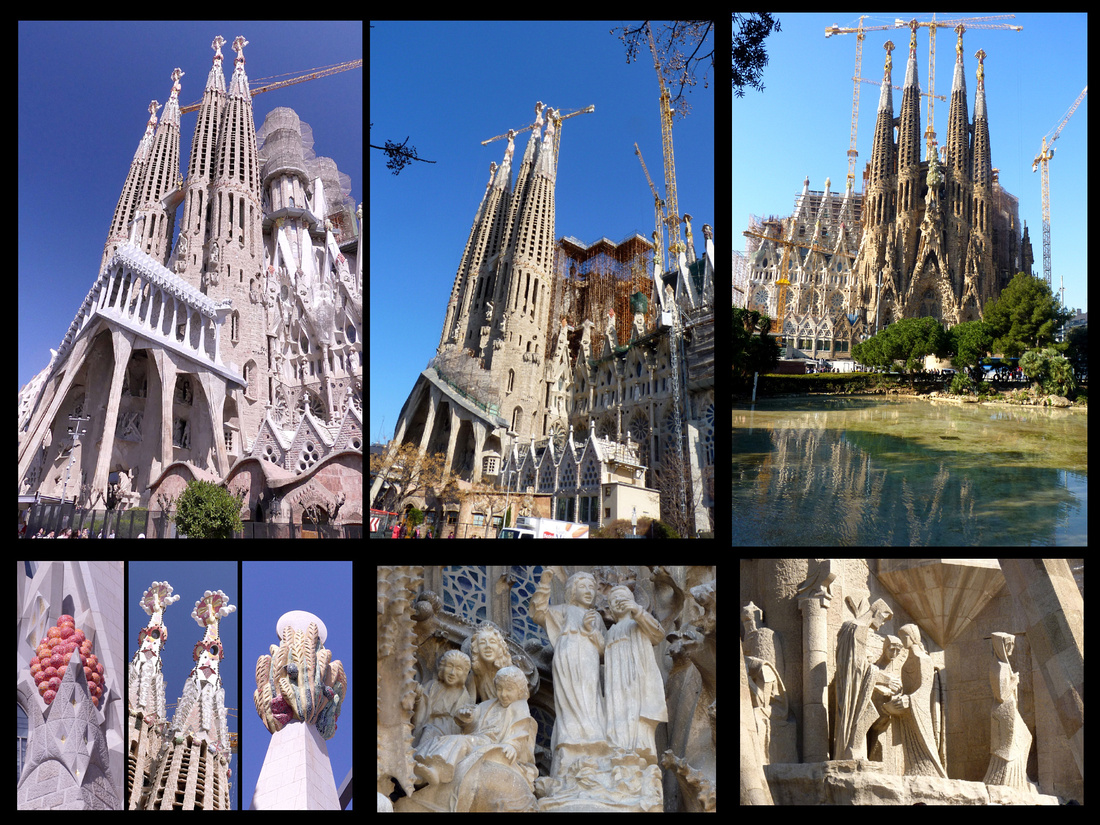

Above - Top left (2019) and top center (2010) show that progress is being made on the cathedral.
La Sagrada Família has become a symbol for the city, and was one of the few churches (along with the cathedral) left untouched by the orgy of church burning which followed the 1936 revolution (although they did burn all the plans Gaudi had left for it’s completion). Begun in 1882 and still very incomplete at Gaudí's death in 1926, this incredible church--the Church of the Holy Family--is a languid, amorphous structure -Art Nouveau run rampant (although George Orwell called it the ugliest building in the world). Work continues on the structure, but without any sure idea of what Gaudí intended. Some say that the church will be completed by the mid-21st Century. Gaudi was only 31 and had not yet been recognized as an accomplished architect when he was chosen to work on it. He worked on the project on and off for 43 years. By then the trend had moved away from Modernisme and money ran low. He sold everything including his home and moved into a hut on the construction site. After his death work continued slowly for the next 75 years but now interest in Gaudi has grown and money is pouring in. It’s the most visited site in Barcelona and the entrance fees of 1.5 million annual visitors are financing an acceleration in the building.
Although basically Gothic in plan Gaudi wanted no buttresses, or “crutches” as he called them. He fussed over every detail and when a bishop asked him why he worried so much about the tops of the towers, Gaudi replied, “the angles will see them”. It was conceived as nothing short of a Bible in stone, a gigantic representation of the entire history of Christianity. Gaudí's plans called for three immense facades, the lateral (Nativity and Passion) facades presently visible on the northeast and southwest sides of the church, and the even larger Glory facade (as yet unbegun) designed as the building's main entry, facing southeast over Carrer de Mallorca. Presently there are eight towers standing. The current spires will be the two sides of the church, the front and back spires – even further apart – haven’t been stared yet. The crypt of the cathedral features a small museum of the architect's scale models.
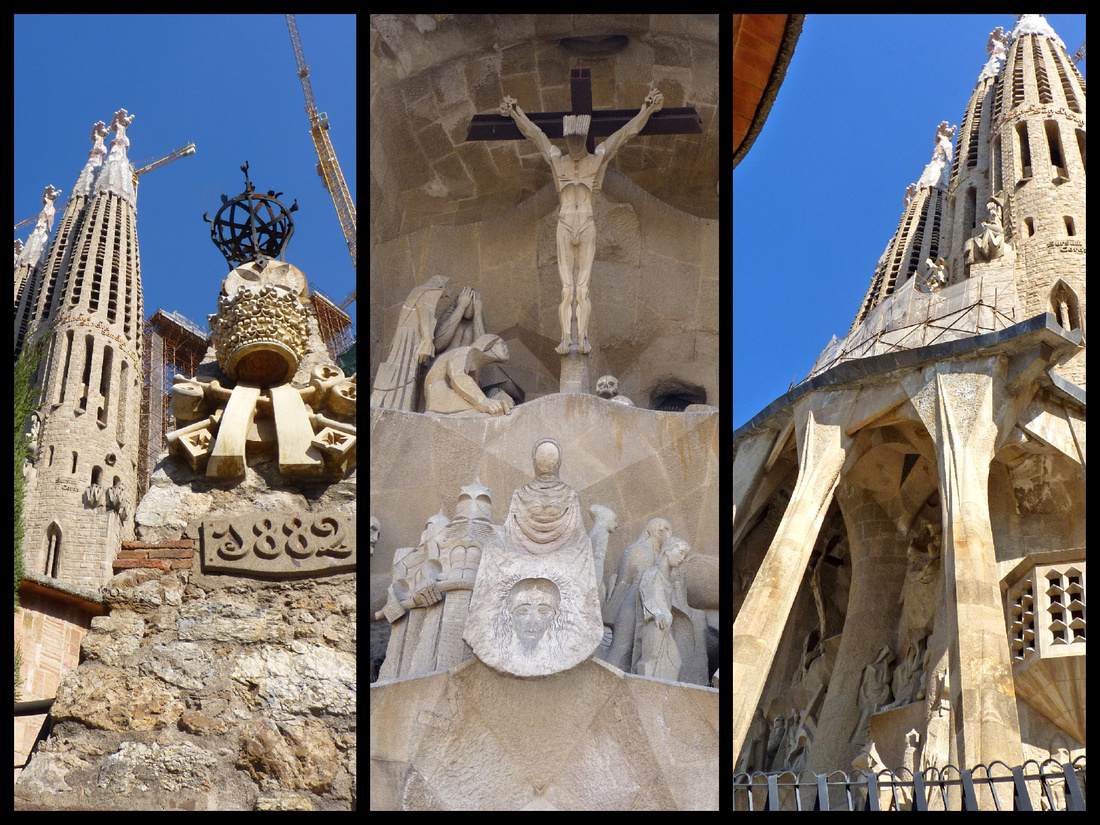

Hospital de la Santa Creu i de Sant Pau - Certainly one of the most beautiful hospital complexes in the world, a 10-minute walk from the Sagrada Família. Work started on the hospital in 1902, to replace the ageing hospital building in the old town (which still stands) with a large, modern and planned series of hospital departments and wards. The buildings are surrounded by gardens and everywhere, turrets and towers sport bright ceramic tiles, little domes, mosaics and lavishly decorated with sculptures, stained glass windows and elaborately wrought iron lamps. It consists of 26 pavilions built on a “human scale” covering nine whole blocks and connected with underground service tunnels. Hospital de Sant Pau is notable for its Mudejar motifs and sylvan plantings. The complex won architect Lluís Domènech i Montaner his third Barcelona "Best Building" award, in 1912. (His previous two were for the Palau de la Música Catalana and Casa Lleó Morera.) The Moderniste enthusiasm for nature is apparent here; the architect believed patients are more apt to recover if they are surrounded by trees and flowers, rather than ensconced in sterile hospital wards.
The hospital complex ceased to function as a real hospital in 2009. A new hospital was built in 2003 located just behind this campus.
A few blocks from Placa Catalunya along Passeig de Gracia is the block known as Mansana de la Discordia, block of dischord, works by not just one great architect but three.
Casa Lleo Morera, Passeig de Graca #35, whose dominant turret resembles a melting wedding cake atop a sea of esoteric ornamentation that includes models of a lion (lleo) and mulberry bush (morera). Built in 1864, it was one of the first in the area. The corner has an ethereal ceramic cupola. The ground floor was designed to house a photographer’s studio so the building has nymphs holding a gramophone as a symbol of bourgeois leisure, another holding an electric bulb and the third a camera. The lions and the mulberry tree adorning the balcony are a play on the family name – Lleo I Morea.
Casa Amatller, Passeig de Graca #41, completed in 1898, has a stepped gable, richly glittered with blue, pink and cream tiles. Its shape in reference to Flanders, once an unwilling colony of Spain (like Catalunya). Between the two doorways are St. George battling the dragon, watched by a swooning princess plus soulful figures representing painting, sculpture, architecture and music, monkeys hammer away at iron while rabbits stow the finished product. A bespectacled donkey engrossed in a book while his friend twiddles with a camera are references to architect Amatller’s love of reading and his photographic interest. Frogs blow glass and pigs play potter by the third window. A window decoration culminates in an almond tree, a play on the family name, with a curling letter “A” surrounded by almond leaves.
Casa Batllo, Passeig de Graca #43, an older building given a facelift by Gaudi in 1904. Barcelona’s biggest allegory of St George and the dragon, covered with a rippling blue skin of ceramic plaques. The roof is the dragons back and the characteristic Gaudi pinnacle with its bulb dome and cross is St George’s lance piercing the dragon. The trencadi-covered chimneys, invisible from the ground are the dragon’s multi-spiked tail. The first floor is the dragon’s lair, the first balcony depicts the rose which grew from its blood, while the other balconies hint at the skulls and tibia in its larder. The balconies of delicate wrought iron look like fishing nets tossed in the air. It’s known affectionately by Catalans as the casa dels ossos (house of bones) -- and sometimes alternatively the casa del drach (house of the dragon).
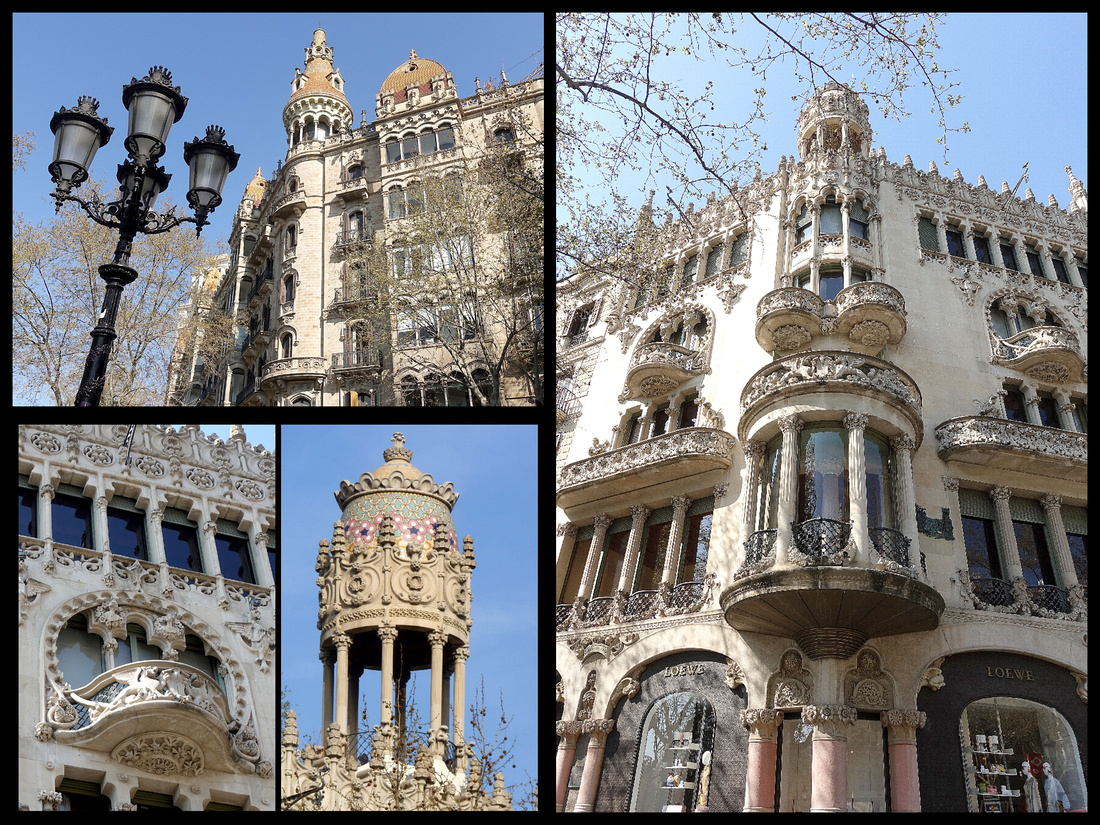

Above: Top Left: Casa Pascuali i Pons (corner of Placa Catalunya) Other photos: Casa Lleo Morera
Above: Casa Amatlier and Casa Batlo
Casa Mila - Begun in 1905 this building is, after La Sagrada Família, Gaudí's most extraordinary work. Nicknamed La Pedrea (stone quarry), its more sculpture than building, like a cliff sculpted by waves. No two balconies are alike. Topped by chimneys so eerie they were nicknamed espantabruxes (witch-scarers), the building was unveiled in 1910 to the horror of local residents. Gaudí's rooftop chimney park, alternately interpreted as veiled Saharan women or helmeted warriors. Espai Gaudi – the attic - is a wavy tunnel of parabolic arches that gives the impression of being inside the rib cage of a dragon – what the princess would have seen if St Jordi hadn’t arrived in time. Inside the attic are excellent critical displays of Gaudí's works from all over Spain, as well as explanations of theories and techniques, including a spectacular upside-down model (a reproduction of the original in the Sagrada Família museum) of the Güell family crypt. The Pis de la Pedrera apartment is an interesting look into the life of a family that lived in La Pedrera in the early 20th C. Everything from the bathroom to the kitchen is filled with reminders of how rapidly and completely life has changed in the last 75 years. People still live in the other apartments. On the ground level is a dreamily painted entrance courtyard.


Above: Casa Mila
Rambla de Catalunya is one of the Eixample’s main shopping streets. It is the district's most attractive avenue, largely pedestrianized and sporting benches and open-air cafés. At the corner of Rambla de Catalunya and Avinguda Diagonal is Casa Sera, moderniste but with Renaissance elements. Just in front of it is one of the more interesting sculptures in Barcelona, "the Coquetta", a lounging giraffe.
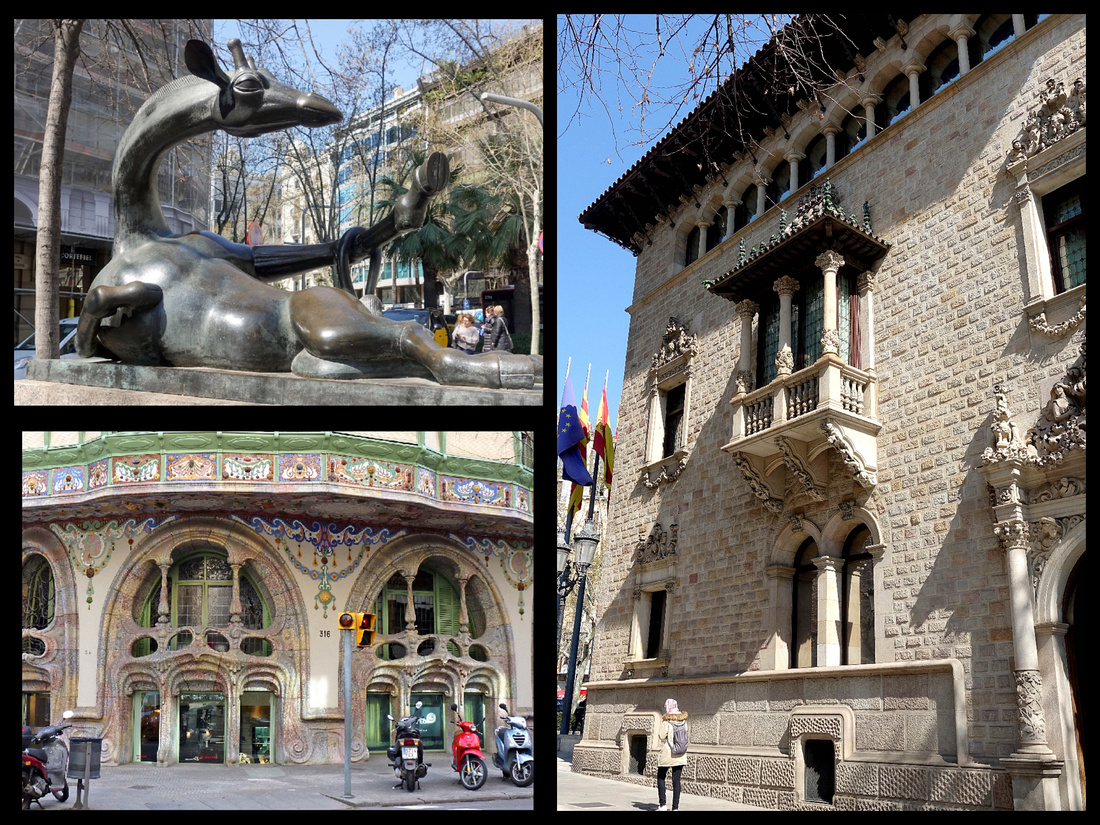



Parc Güell is where Gaudí turned his hand to landscaping, with spectacular results. Huge ceramic benches, giant decorative lizards, ceramic mosaics and pavilions of contorted stone all combine into a brilliant swirl of the imagination. Eusebi Guell bought two farms here in 1902 with plans to lay out an exclusive English garden suburb with 60 homes, a market, paths, gardens, etc. He gave Gaudi free rein to design the entrance, lodges, a central market and terraced walks. Although Guell left his fancy Gaudi designed home in El Raval to live here, none of the homes were ever built and when he died in 1918 his family donated the site to the city.
The Grand Stair – swoops around the most jovial salamander imaginable, clinging to the fountain and covered with brightly coloured trencadis that symbolize fire. Guell studied in Nimes, a city that was Catalan in the middle ages and which has a Place de la Salamandre. Trencadís is a type of mosaic created from broken tile shards. The technique is also called pique assiette. Gaudi used trencadís in many projects among which Park Guell is probably the most famous.
Sala Hipostila was planned as a covered market. The cavernous Sala is known as the Hall of a Hundred Columns (there are only 86), a thick forest of Doric columns which are hollow inside to allow rain water to run down into a vast cistern to store water for emergencies. Above it is a broad open space whose centrepiece is the Banc de Trenadis (Serpentine Bench), a tiled bench curving sinuously around its perimeter. To form the mold of the seats, Gaudi got a naked man to sit in wet plaster.
The spired house to the right of the main entrance is the Casa Museu Gaudí, where Gaudí lived for most of his last 20 years with his father and neice. The house was not designed by Gaudi, but by Francesc Berenguer as a house to show potential buyers but when there were none, Gaudi bought it. It is a pink, Alice-in-Wonderland house with green shutters and cream swirls around the windows and doors and a chimney covered with trencadis and a garden filled with sculpted flowers which Gaudi wrought from bits of cast off fencing.


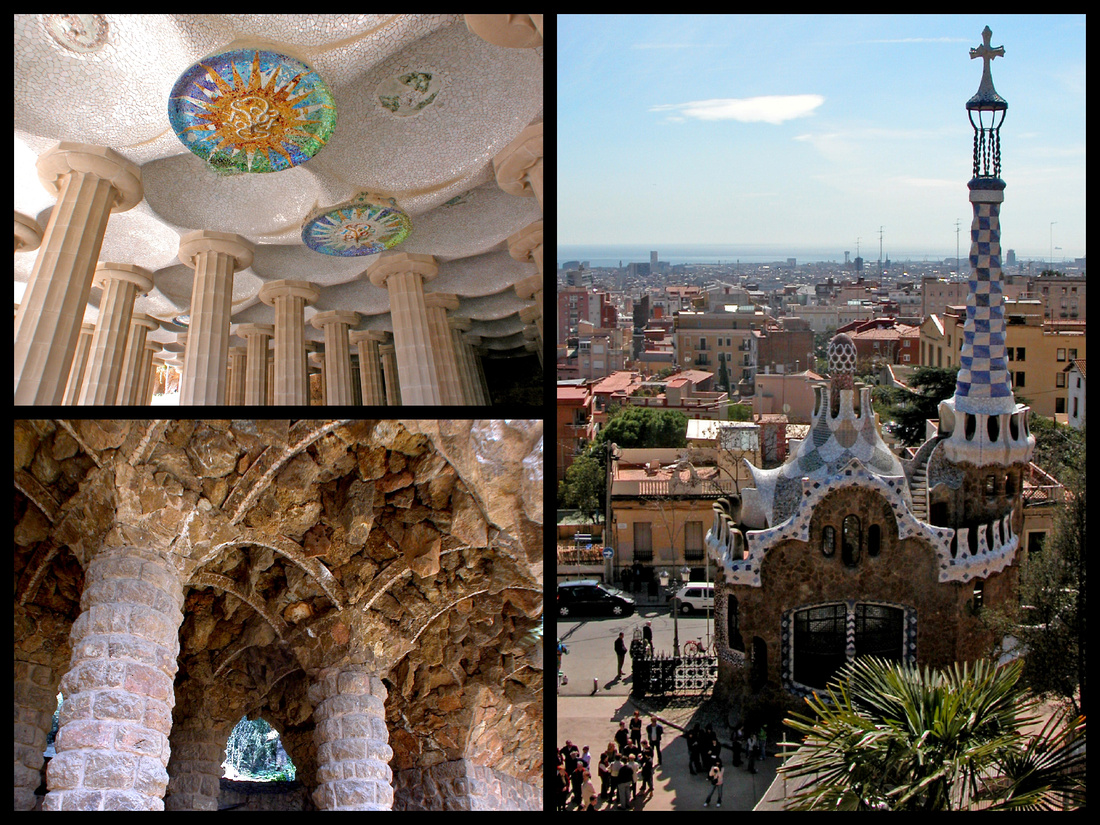

Monjuic - Placa d'Espanya is one of the busiest plazas in Barcelona, home to Barcelona's bullring, and flanked by striking 47-metre high towers. Avingunda de la Reina Maria Cristina heads up towards Monjuic. Stretching up the avenue are a series of terraces and several large fountains. At the top is Palau Nacional, which although looking old was actually designed for the 1929 exhibition, and now houses the Mluseu Nacional d'Art de Catalunya. On the other side of the Palau are the buildings and grounds from the 1992 Olympics.
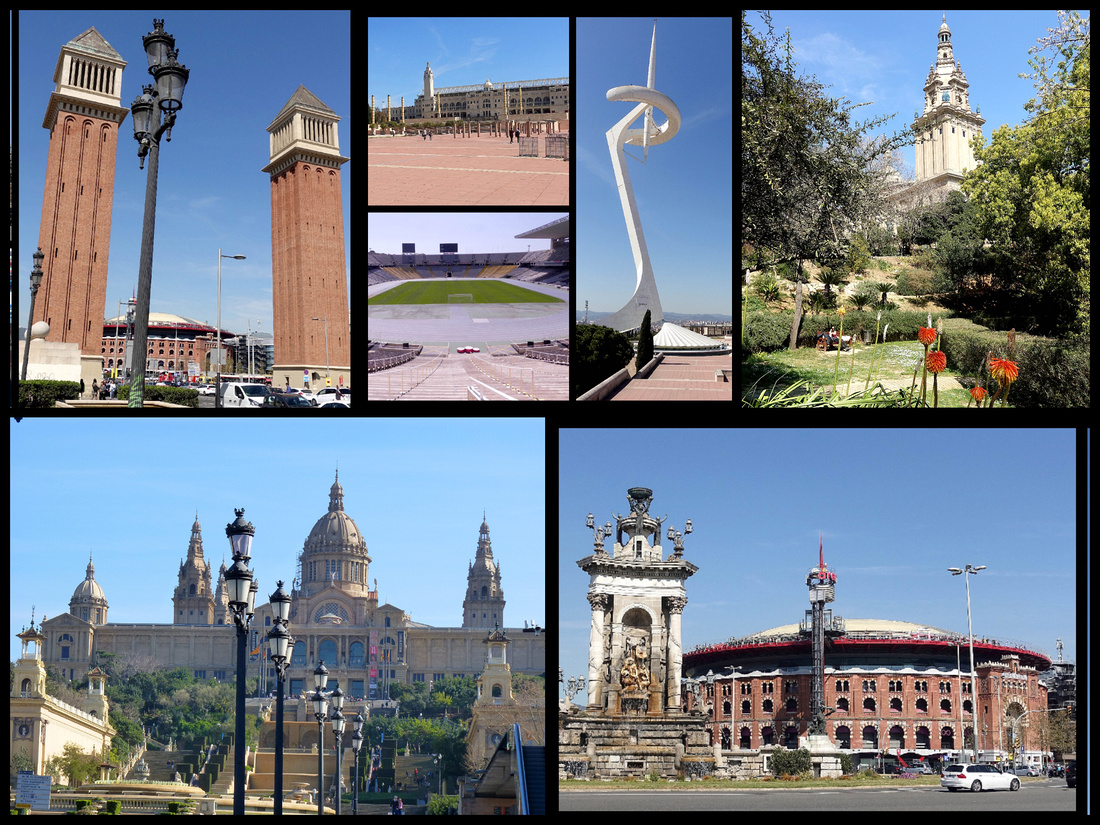

Poble Espanyol - A short walk to the western side of the Palau Nacional is the Poble Espanyol ("Spanish Village") A complete village consisting of streets and squares with reconstructions of famous or characteristic buildings from all over Spain. It was an inspired concept for the International Exhibition (and since then copied, world over at 'World's Fairs').
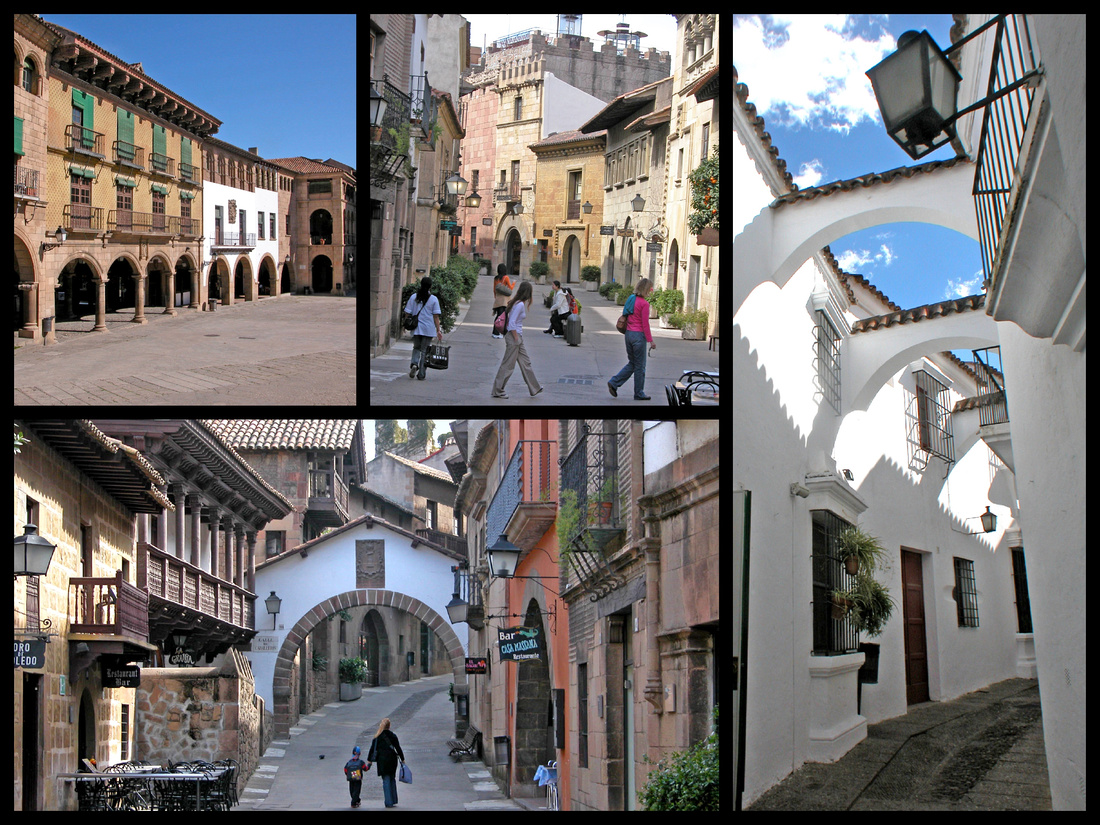

Monestir de Pedralbes With its triple-tiered cloister, gardens, convent kitchen and refectory, (and Rubens, Titians, etc. from the Thyssen-Bornemisza Collection), this is one of Barcelona's best secrets. Founded in 1326, the convent has an unusual, three-story Gothic cloister. You can also visit the medieval living quarters. There’s a large refectory, a fully equipped kitchen, an infirmary (complete with beds and water jugs), a separate infirmary kitchen and a well-tended kitchen garden.
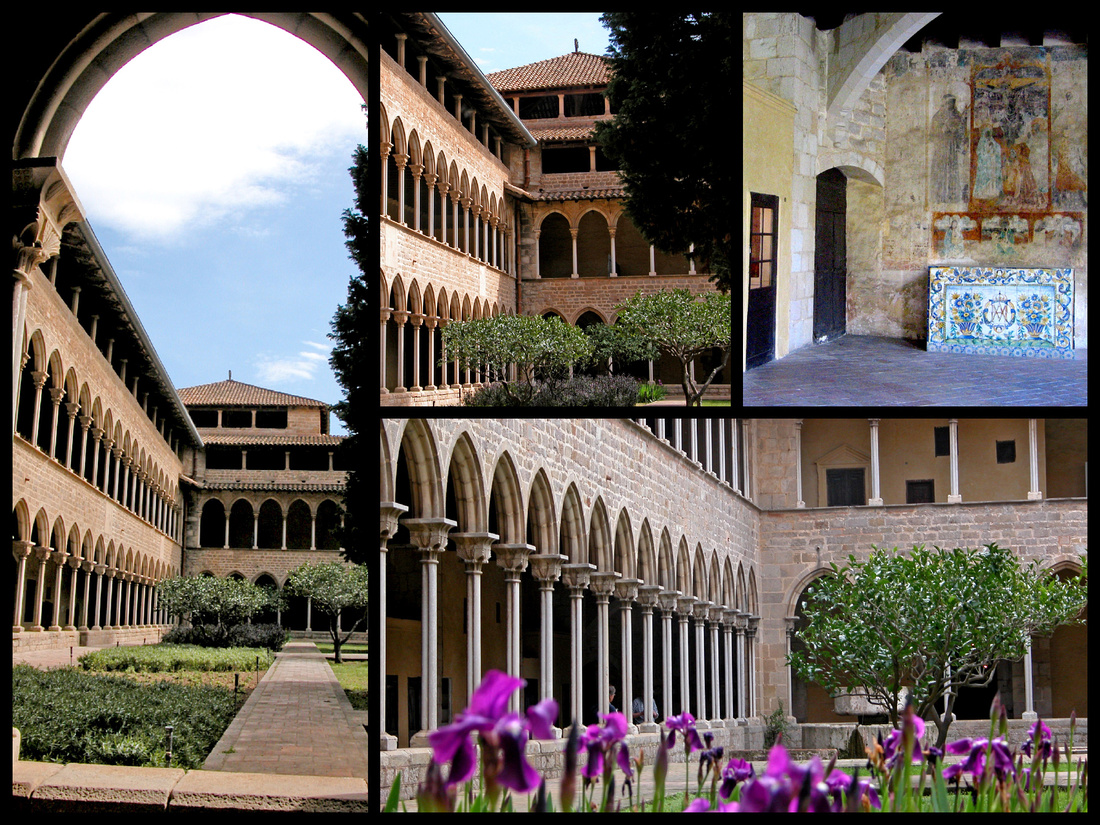

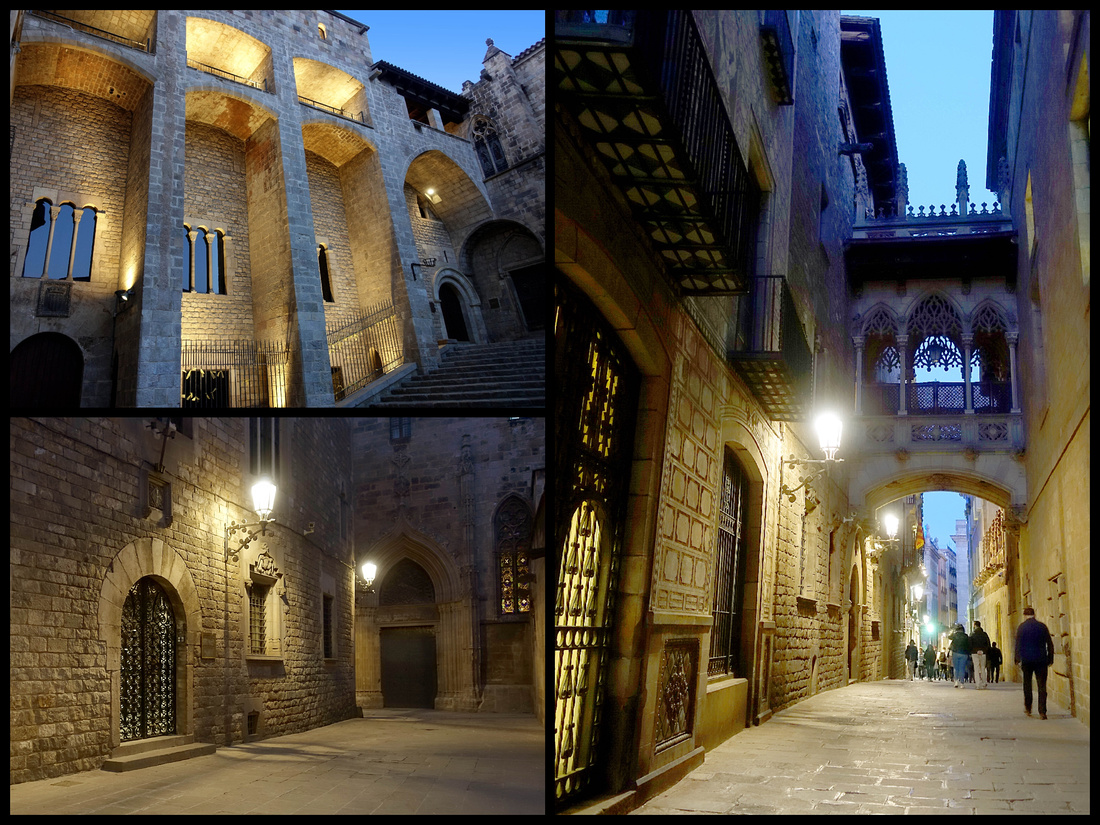





Comments
Jeff
http://www.printradiant.com | http://www.printlinkage.com | http://www.hitsticker.com | http://www.stickermac.com
